If you haven´t read it yet, you might start with Parts 1, 2 and 3 of the #biscaysailing series by clicking here.
I went down and into my bunk just after we had cleared Brest approach buoy and FREE WILLY was on course toward the narrow channel that blocks the bay from the Biscay-waters. It was pitch black outside, buoys were blinking and whilst Skipper and Markus appeared to be wide awake I signed off and crawled into my warm sleeping back. And yes, I fell into a deep sleep although the engine was running at 2.200 rpm. It was three or four, maybe 5 hours later that I finally got up again and stuck out my head into the cockpit: “Good morning, mate!”, the Skipper greeted.
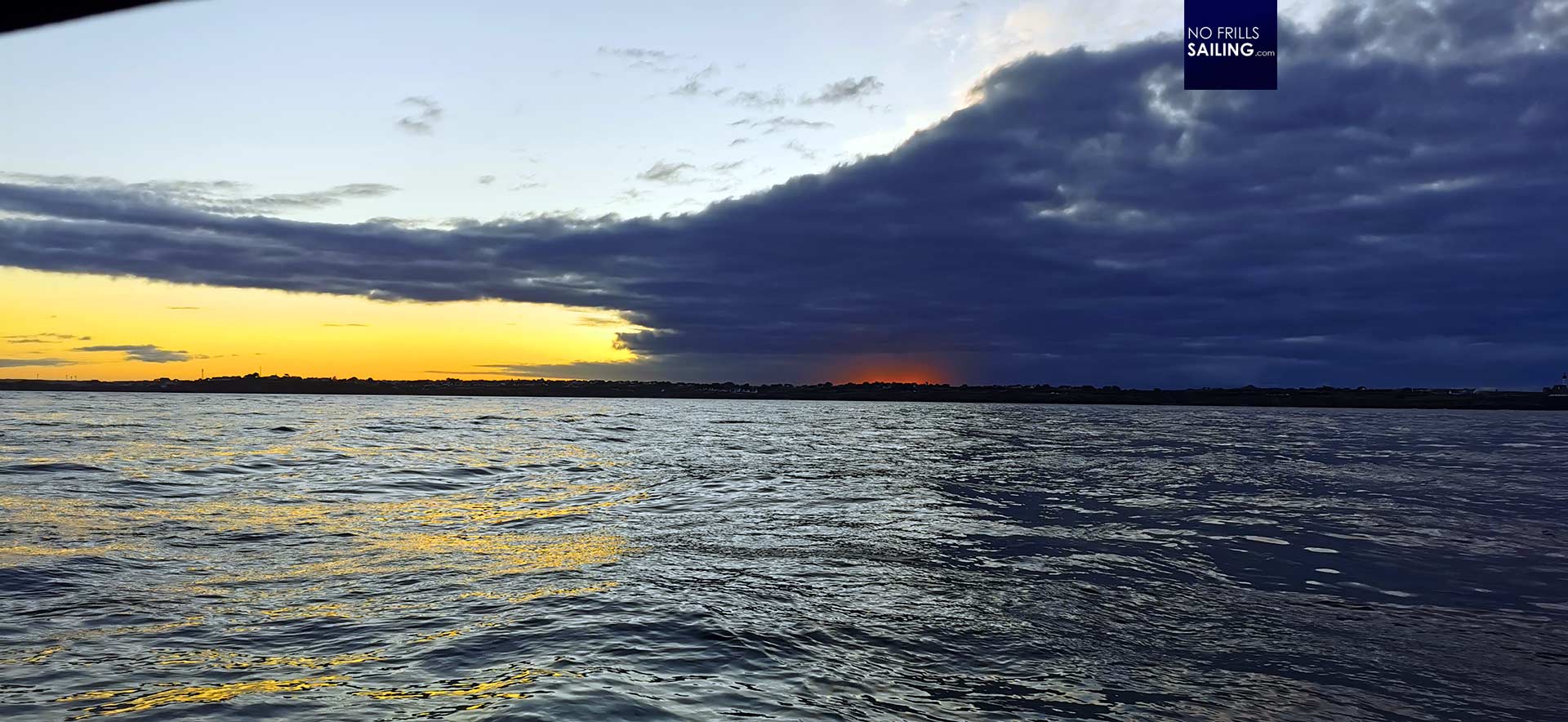
Markus apparently had signed off as well as he was pleasurably snoring in his bunk. I readied myself, brushed my teeth and prepared a coffee which we drank together watching the sun coming up. Skipper wasn´t happy at all. He told me that they slipped out of Brest with falling tide not as fast as we´ve predicted, tidal stream came off pretty weak. “Now the water is rising again and we have it right into our bow!”, he crabbed: Looking onto the plotter I saw it – 3 knots over ground. Ridiculously slow.
Into the famous English Channel
Nevertheless, the sun came up ever so glorious and Skipper went down as well to catch some sleep. We steered due North and to our right hand side France was passing by (very slowly) whereas I was very interested in scanning the Ile Molene and Ile Ouessant with the binoculars. Checking Google Maps I decided that these islands, inhabited, would be perfect for a visit. Just one small village, loads of small fishing boats, one store, one church: I envisioned a pretty, rough and original scenery. Well, probably nothing for a boat with a 2 metre draft but maybe something for a smaller boat with variable draft?
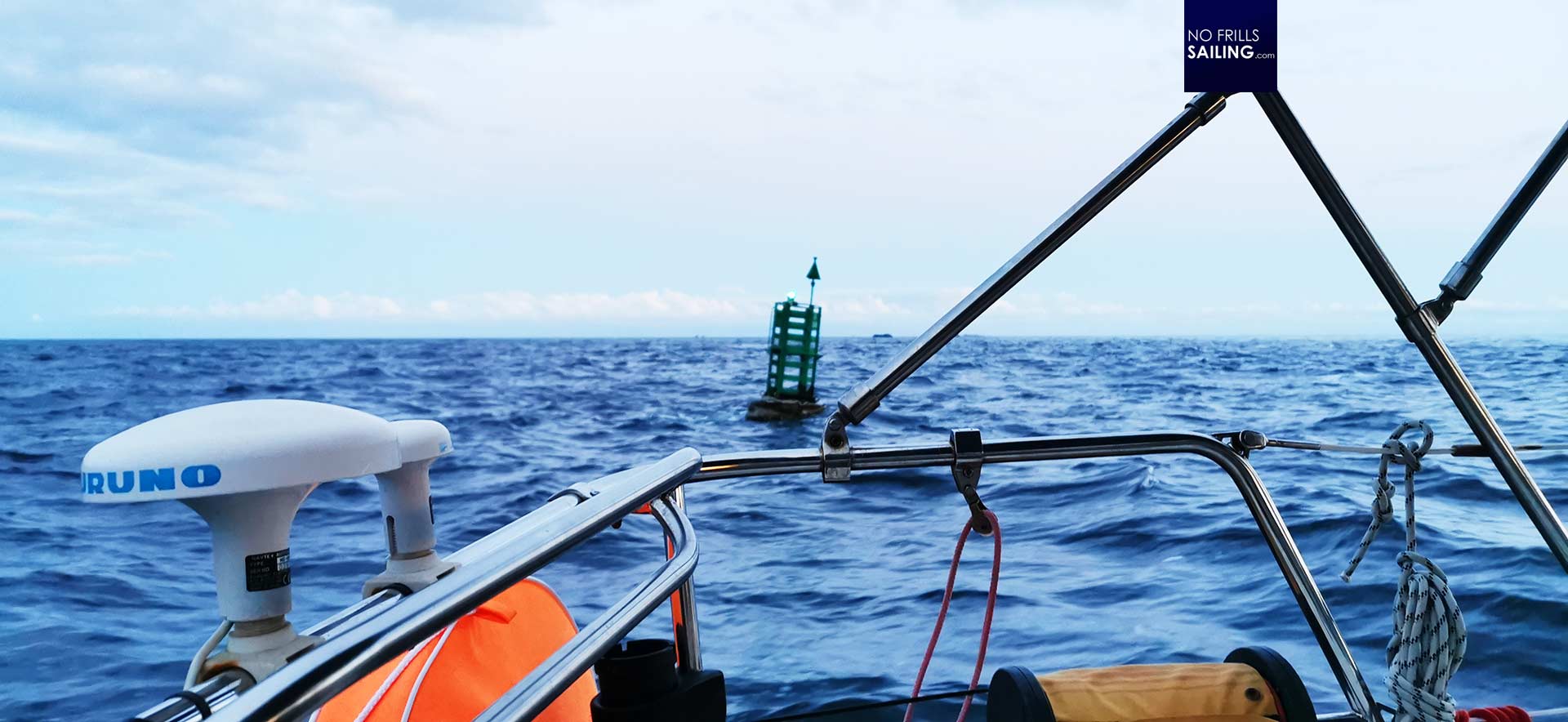
I passed yet another fairway buoy which was hanging onto its anchor chain, tilting noticeably to one side. I observed a gurgling wake. Both signs of a proper current and the proof of a very strong tidal stream here. Checking the tidal informations on the boat´s plotter I learned that this current was about 3 knots as of this very moment which perfectly explained why we did not made any large progress. On the other hand: The view was just fantastic!
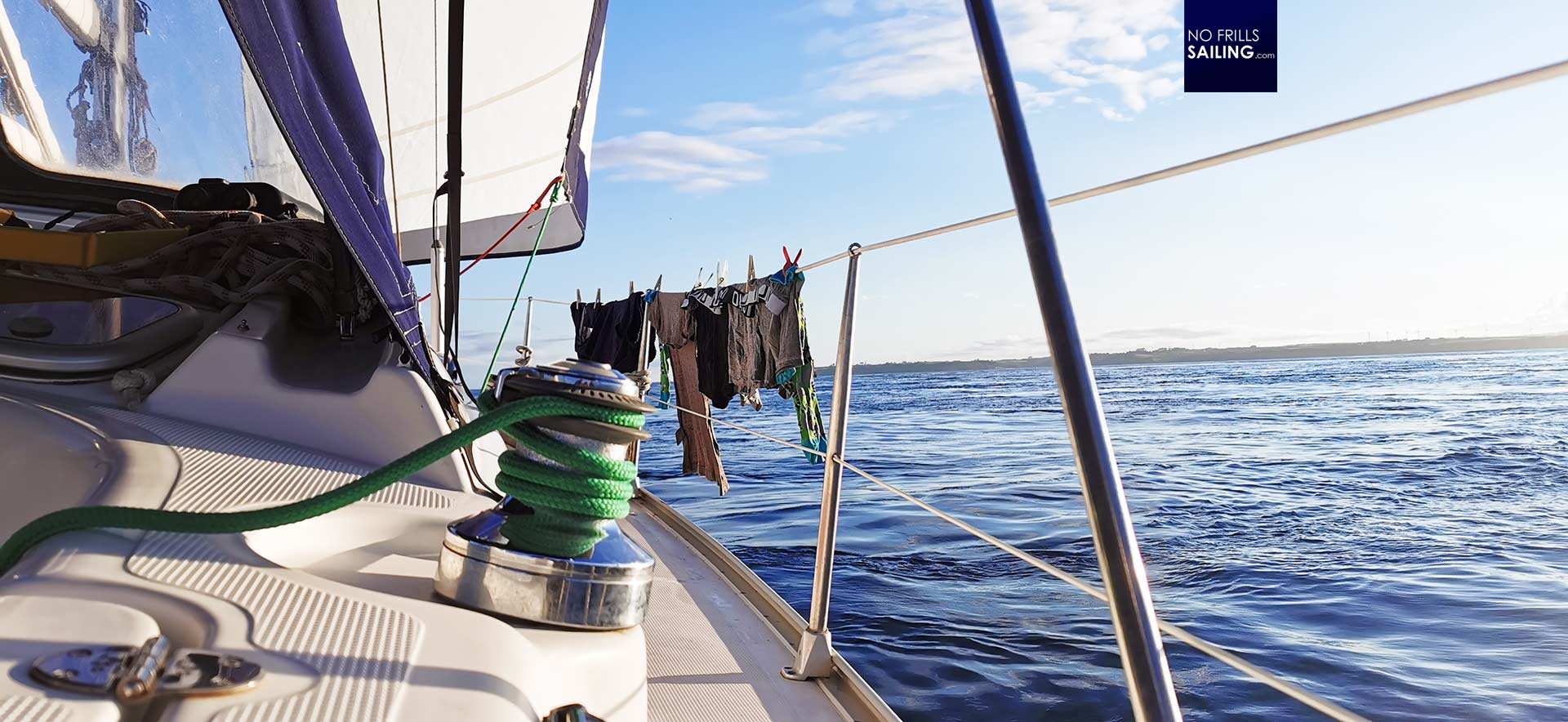
As the sun came up over the Brittany hills to starboard side, I went down and had some steaming hot water poured into the sink. Then I took out all the used underwear and some T-Shirts from my cabin and began to wash them properly. On all of my sailing trips I take far too much stuff. One fresh underpants per day – that´s a proper rule BUT you don´t need to take as many pants as sailing days with you. One can wash in between. This was the first time I tried it and as we had been midway in the trip, I proceeded. Putting them onto the reeling the stuff dried within a couple of hours.
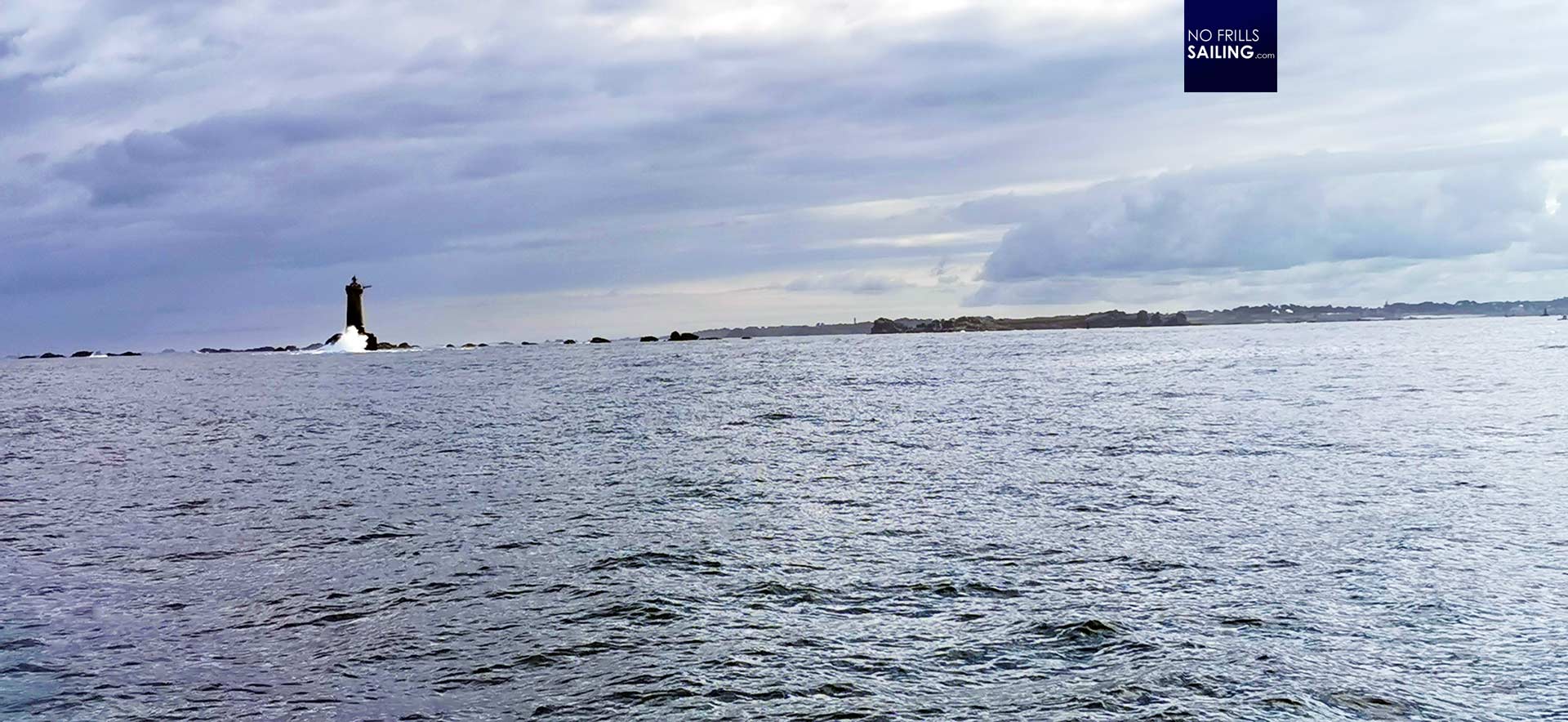
Finally some wind began to blow from the West – as expected – and I took out the Genoa. It just was a breeze which not really contributed to the speed of the boat but the pressure in the sail was enough to heel the boat to starboard and take off some of the motion, FREE WILLY didn´t roll as much as before and I hoped my sleeping crew mates would appreciate that service. We passed a lighthouse which marked the end of the strait and thus the beginning of the English Channel. I again pitied the fact that we did not have enough time to explore the region: Just one mile to our right a most famous area where one could see Dolmen, pre-historical graves made out of huge stones.
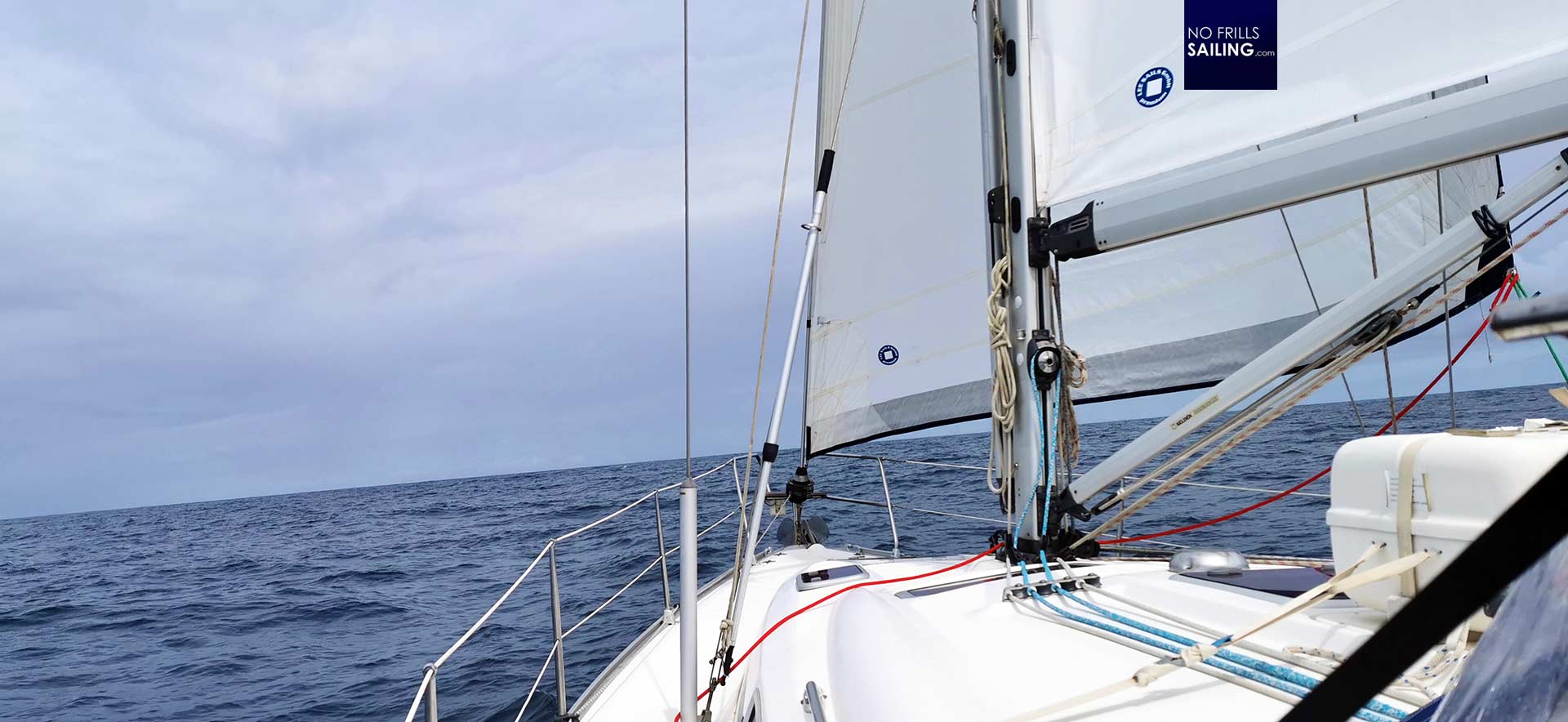
As we drifted by the light house and the vastness of the English Channel opened up before the bow of the boat we cleared the lee of the islands to our port side and more wind was able to reach our boat. So I took out the mainsail as well and – behold! – it was enough wind to propel the yacht. Switching off the Diesel after some 8 hours of running since we´ve left Brest was a true boon – and NOW my fellow crew mates really thanked me by rolling over to another side, dreaming themselves away and enjoying a stable sailing boat, rolling so gently, in complete absence of any artificial noise.
English Channel: A completely different experience
After a while Markus came up, got ready and relieved me off of my duty one hour earlier which I found terrific because tiredness had put its grab tightly and I longed to a few hours of deep sleep after that short night and another free watch next to the engine. I went down and immediately fell aslepp. This is how I missed our glorious entry into the English Channel – on the other hand, that “night” I did finally have a very relaxing sleep which replenished a load of the lost energy.
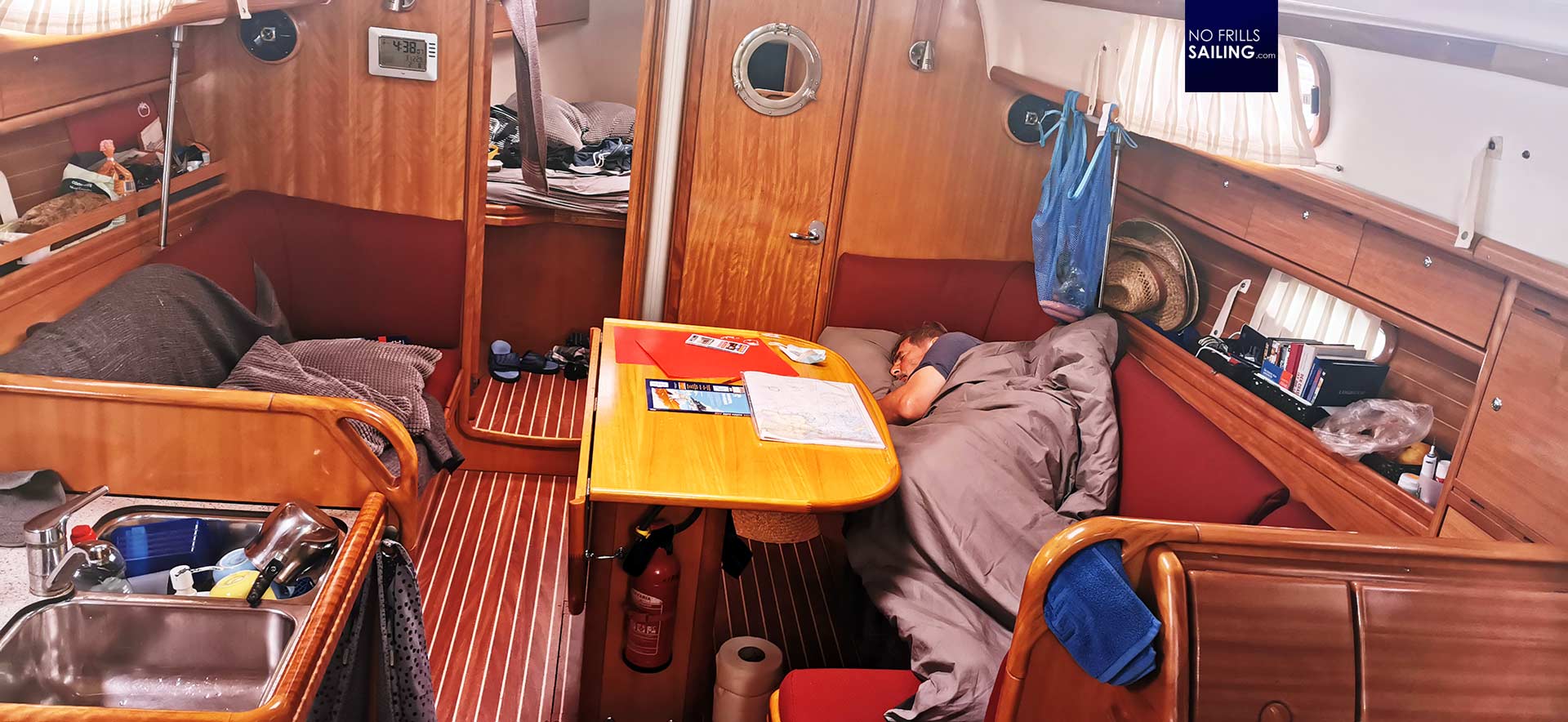
When I got up after nearly five and a half hours later the day was almost over, Markus off duty and sleeping in his respective cabin again and upon relieving the Skipper it was now my turn to get acquainted with the Channel. Wind-wise everything was just perfect: A steady breeze from the West – much colder than the warm Easterly of the Bay of Biscay, much stronger as well – was pushing the boat forward into the busiest waterway of the world. We´ve had the boat under full canvas again and she was sailing just fine. Before me, in the last daylight hours of the day, the English Channel looked also different from what I had expected.
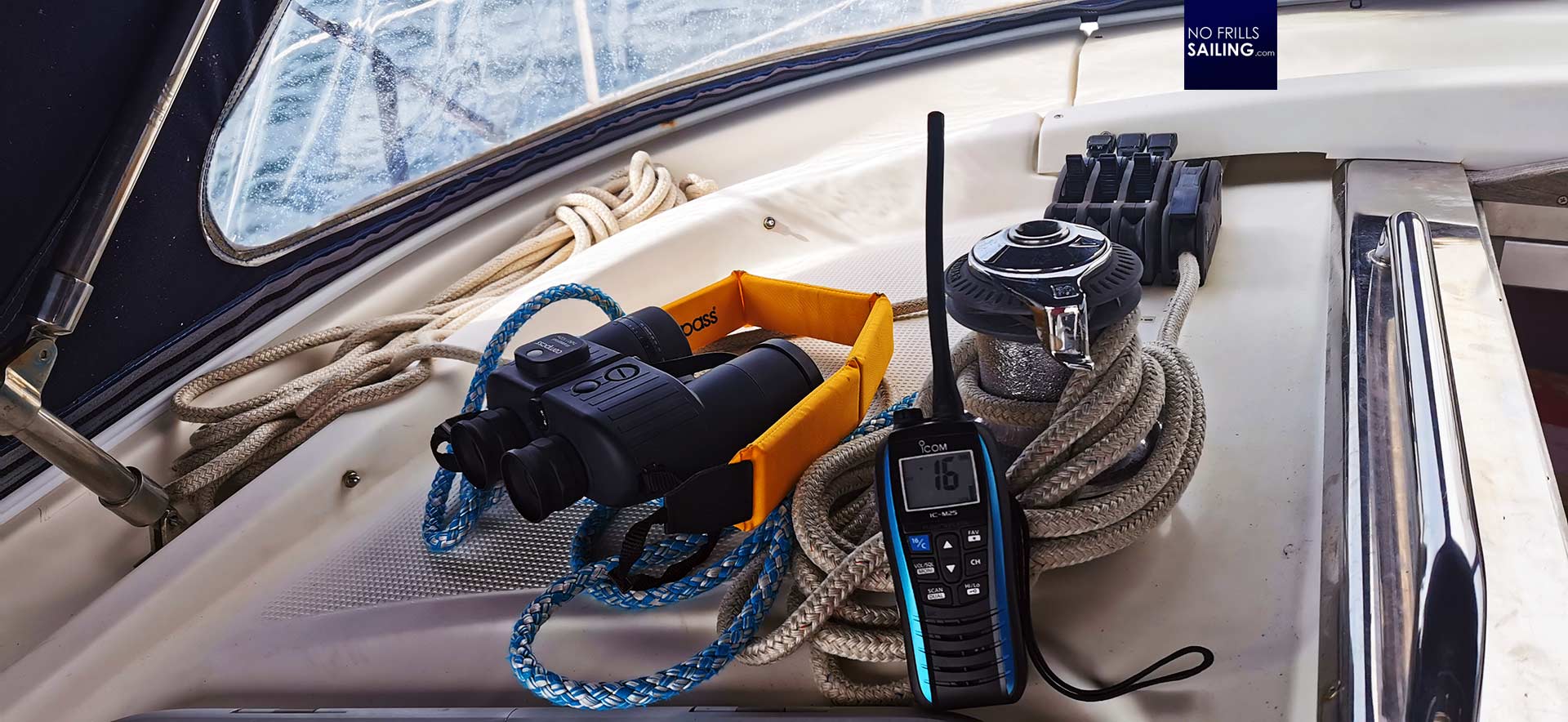
It was a vast plain of water. In my head, the Channel consisted almost solely of these classic pictures of the Cornwall coast, the white cliffs of Dover and an endless procession of ships gong through in both directions. Now, what I saw here was completely different: No land in sight at all, just water and barely any contacts on the AIS. Well, “barely” does not mean that there weren´t any: In a precaution I prepared the handheld VHF-transceiver and the binoculars within reach up in the cockpit as I thought maybe it´s clever to have these available at hand up here.
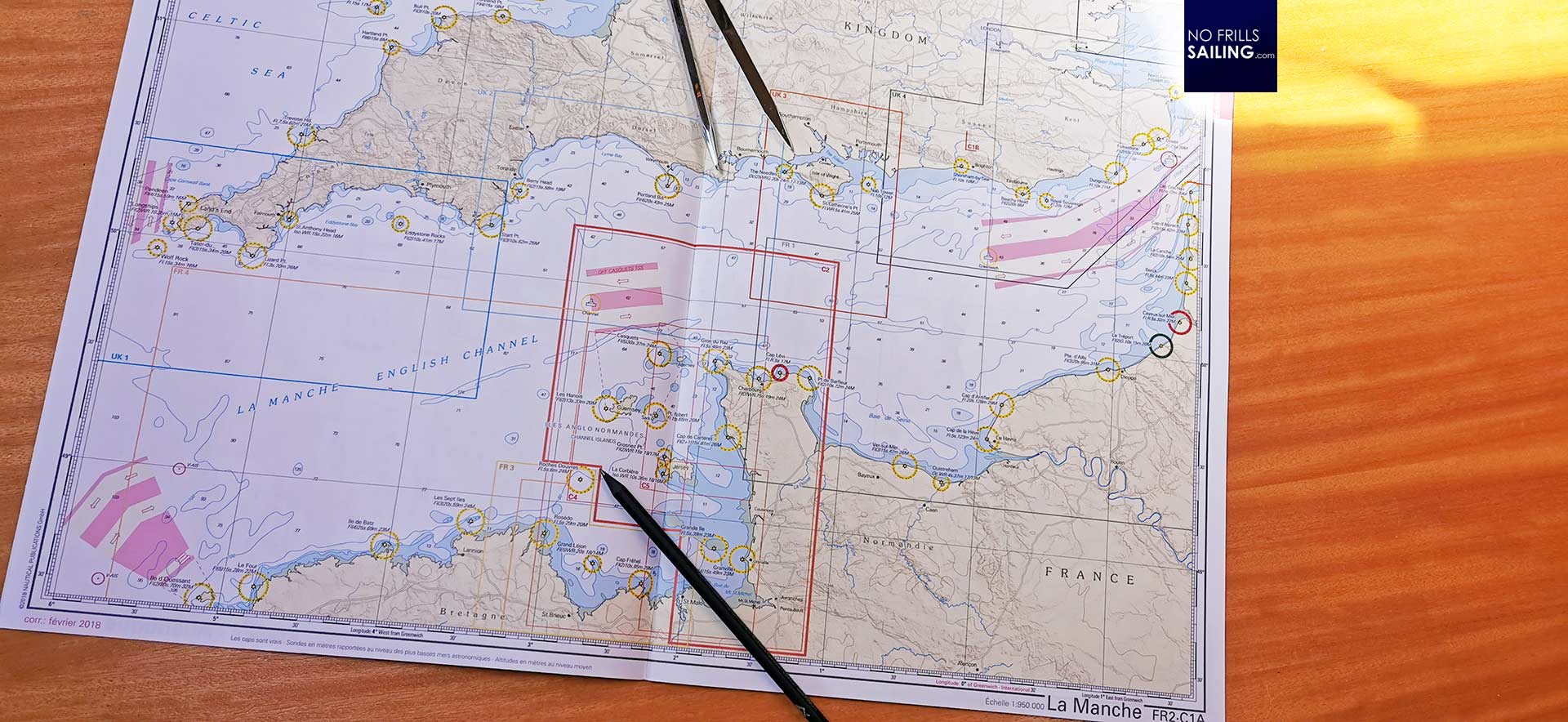
Looking at the naval charts I re-called that the English Channel is far from just being a narrow passage. It is indeed shaped like a funnel or cone with a width of some 150 miles in the West – just the area we were cruising now – and only about 20 miles in the East at its narrowest points between Dover and Calais. Also, the often talked-about Traffic Separation Schemes (TSS – one-way “Autobahn” for fast commercial traffic) aren´t that dominating here in the western part: Good for us, I altered course of the boat and aimed at the southern tip of the Isle of Wight, leaving one TSS to our starboard side and one to the port side. During change of watch I had talked about the Channel-strategy with the Skipper.
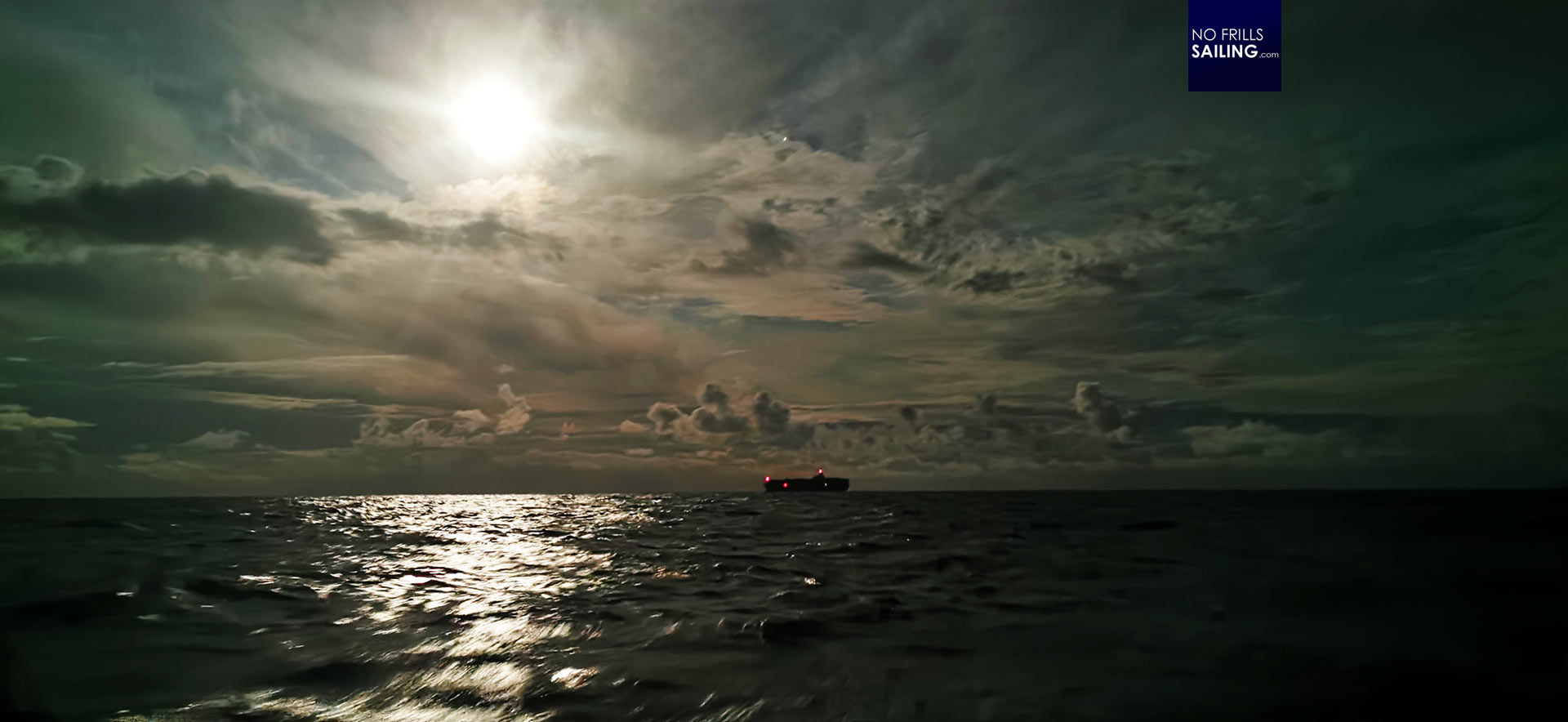
We agreed that – reading some pilot charts and blogs of other crews – tidal forces would be more apparent in the southern – France – part of the Channel. Also, with the general course and westerly winds it would be more clever to choose a route along the English coast: As weather forecast predicted a fairly stable situation for the coming four days the chance of a calm and need to run the engine – and thus refueling – was minimal. As due to Covid-19 landfall in the United Kingdom was forbidden, we would have had to sail to France and a route in the North would have meant to go south again and cross the TSS. But opted against that variant. As night fell – just as if somebody had pushed a button – the plotter became littered with AIS signals.
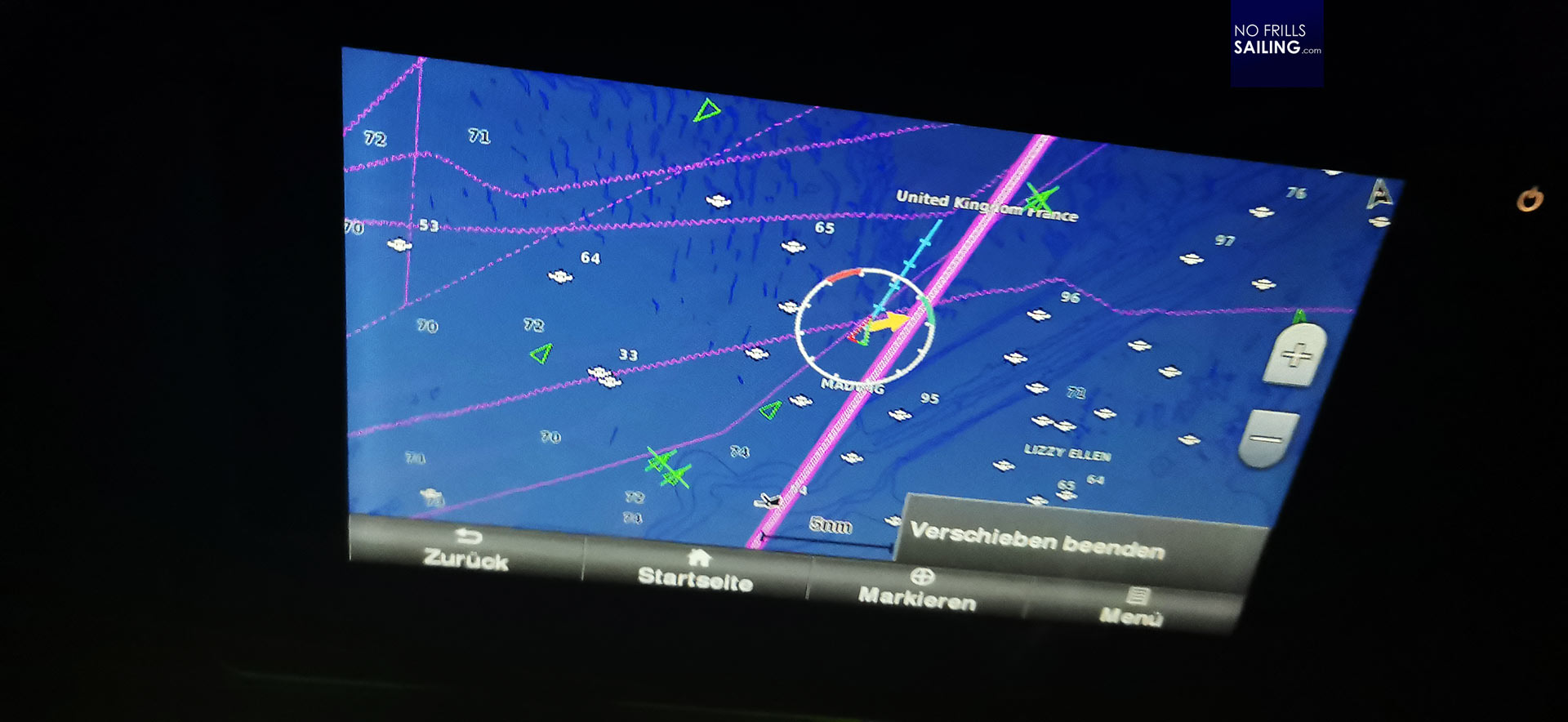
We dashed through the water: FREE WILLY cleared the path of the shipping lanes so that the huge ships, some of them large 440 metre Post-Panamax behemoths, brilliantly illuminated and flying by with 19 knots. Wind was up and blowing, during my watch wind speed increased from 16 to 24 knots in average and so the boat jumped to live. It became rather unpleasant down below because as we were on a reaching point of sail with waves as high as 2 metres running past below us, the boat rolled heavily and went from 18 to 18 degrees on either tack. Every fifth wave or so we broached slightly but the auto-pilot managed to bring us back on track with ease. When I woke up Markus to take over, high tide kicked in and put us onto the fast track …
Lucky us: Perfect weather window for the Channel
I cannot really say what happened during this next watch below as again I fell asleep ever so tightly and did not wake up until 5.5 hours later. It was dog´s watch and when I came up on deck Skipper sat there with full foul weather gear and gloves. Seeing him from below I feared a change of weather, rain and possibly a cold front, but it luckily just turned out that he was a stove-sitter. Back on deck we still hat 20 to 24 knots of gusty winds coming in from behind, the boat was running like hell.
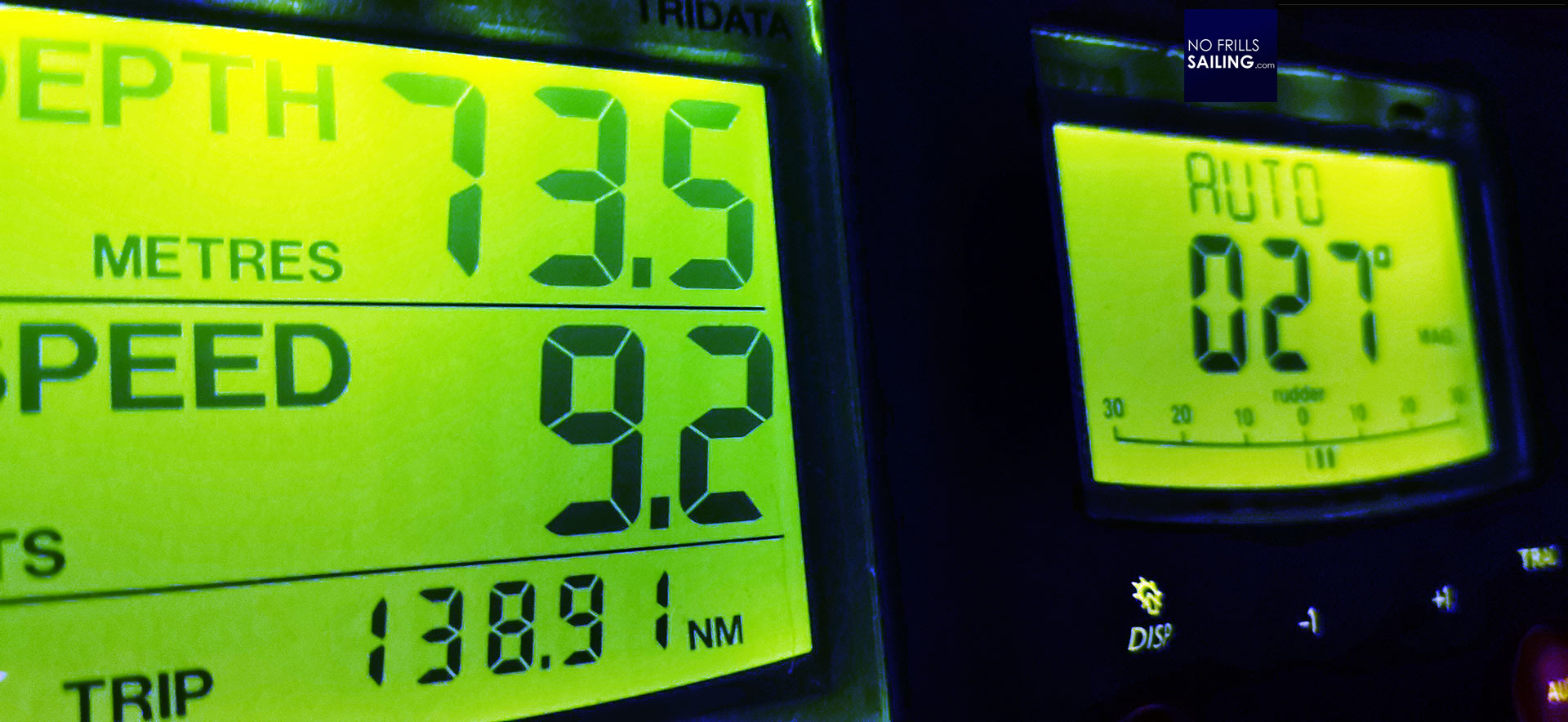
I found it particularly interesting to observe the traffic. The ships – now some 5 to 8 contacts at any given time on the plotter but still far less than expected, maybe due to Corona? – kept a distance and always altered course. Although both, Markus and the Skipper, would later tell me that they had some unpleasant encounters with a cruise ship and a larger fishing vessel forcing them to alter course and even have them called via VHF, I must say that all ships during my watch behave just perfectly by the book, respecting collision prevention rules.
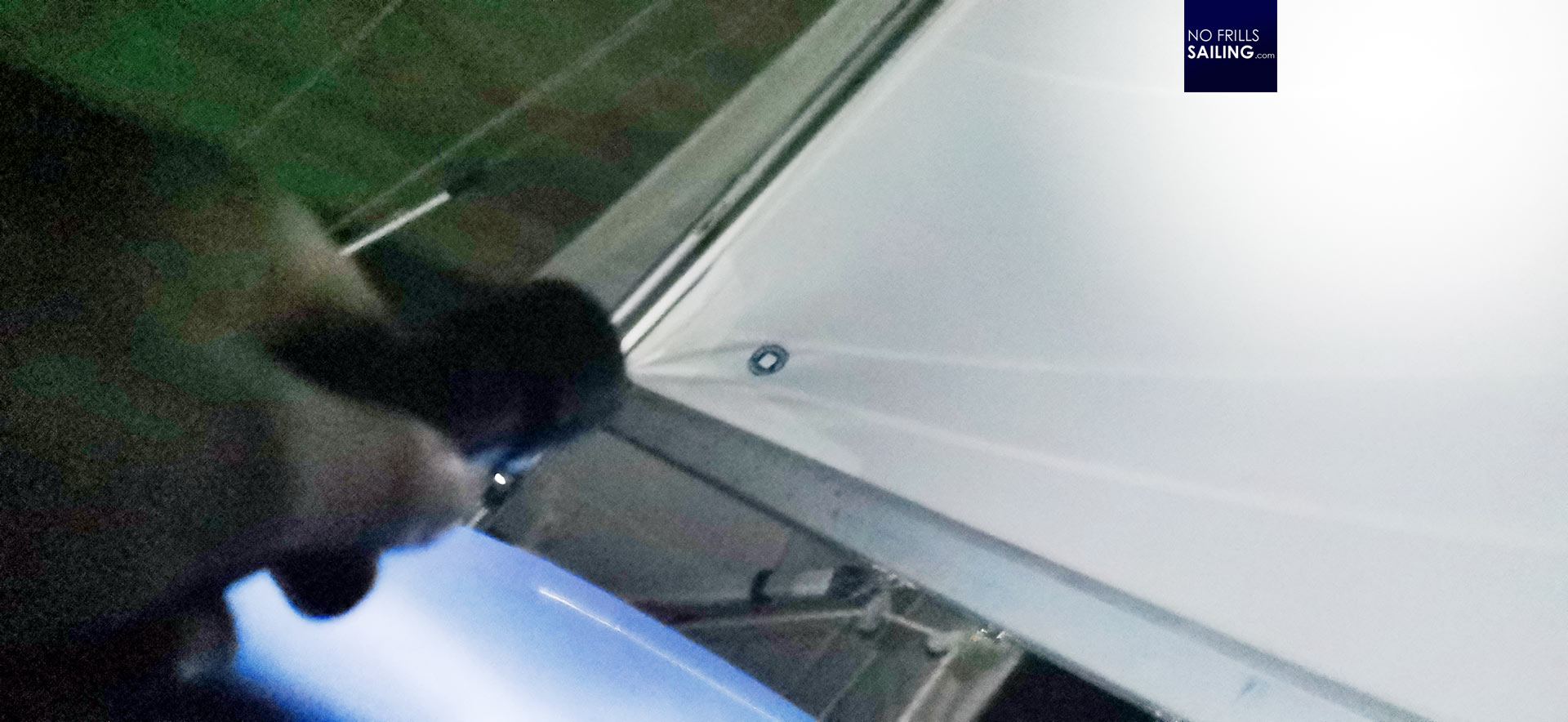
After the first hour wind began to pick up strength again. With gusts falling in regularly taking the Windex to report wind speeds of up to 30 knots we still had full canvas up. Now, the auto pilot steered confidently and even when a huge wave coming it from the stern made the boat broaching, bringing her to a pretty neat heel and putting her bow more than 40 degrees off course, it managed with a stubborn confidence to bring her back on track after some seconds. Just an awesome technology and definitely a must for a seagoing vessel – controlling the boat by manual helming in these conditions, at night, with no visual reference would be a nightmare. I now regularly checked the pressure in the sails with my flashlight – a true skipper´s essential – but didn´t judge to take in a reef yet.
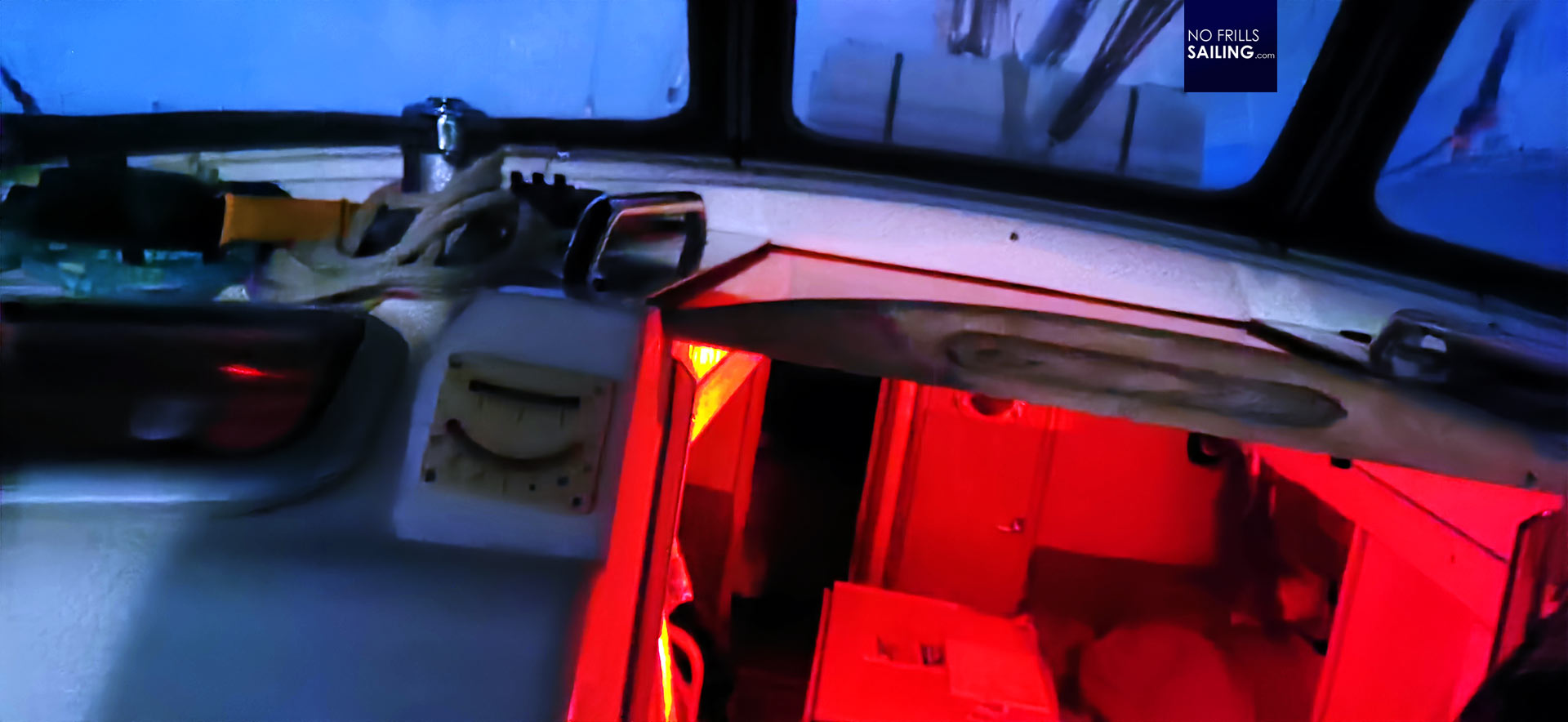
Time went by ever so slowly that night. As the boat did not have a preferred tack and was tumbling, rolling and sometimes rocking very hard in the waves of the Channel I couldn´t find a stable, comfortable position and had to wedge myself in between the coamings and the cockpit table. During a broach I would then be catapulted off the benches. Not the most pleasant of night shifts but most certainly – sailing wise – the most exciting. I reckon that was my fastest watch. Anyways, when the tide turned and we had to sail against the falling water, speed over ground went down to a meager 3 knots or so with speed through water being up still, but at that time the sun was coming up again and my watch nearing its end. Waking up Markus, highlight of every watch – going down to catch some sleep.
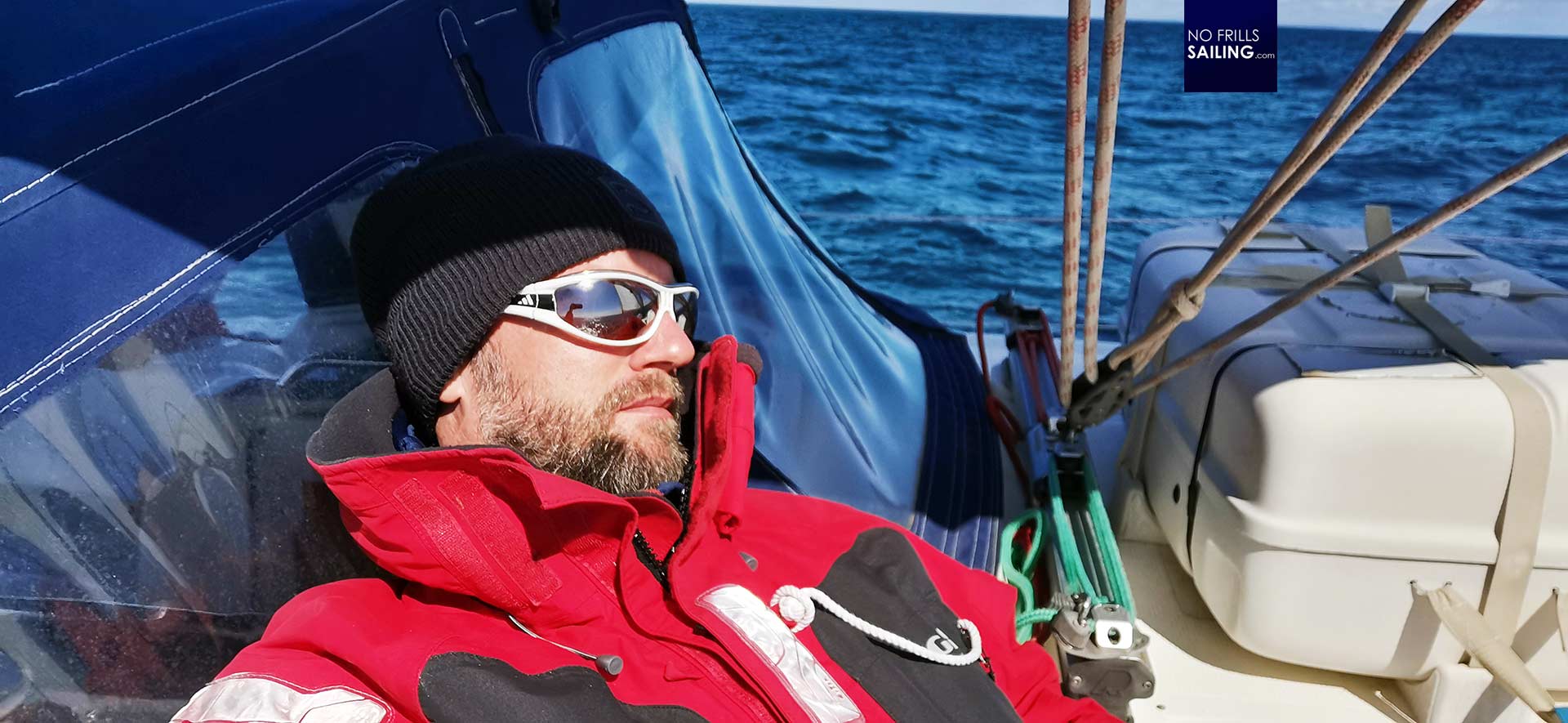
Well, not quite much this day: As during my night-watches we had passed the Isle of Wight and now Brighton (midway through!) we now had the coastline of Eastbourne and Hastings off the bow. It was just a great pity that there was no chance to make landfall in the UK – damn Covid 19! What would it have been to see Southampton our Portsmouth, Teignmouth, home of ill-fated Donald Crowhurst or even sail to the Scilly Islands in the first place? Even the Channel Islands of Guernsey and Jersey in the southern part would have been a bliss to see. Now, I remained on deck, put myself to the fore deck and stuck my nose into the warm sun: Under no circumstances I wanted to miss seeing the “real Channel”
English Channel – Traffic Separation Schemes and shipping-lanes
Well, it came faster than expected. As we made progress further into the funnel of the Channel, the TSS came nearer. The influence of the tides became more and more apparent as during falling waters the boat speed (SOG) was slowed down to not more than 2.8 to 3.2 knots, during high tides the boat sped up to 9 knots. We travelled well within sight of the land with under 4 miles distance, keeping as much distance between the TSS and us. That brought us also nearer to fishermen and their little red marker-buoys.
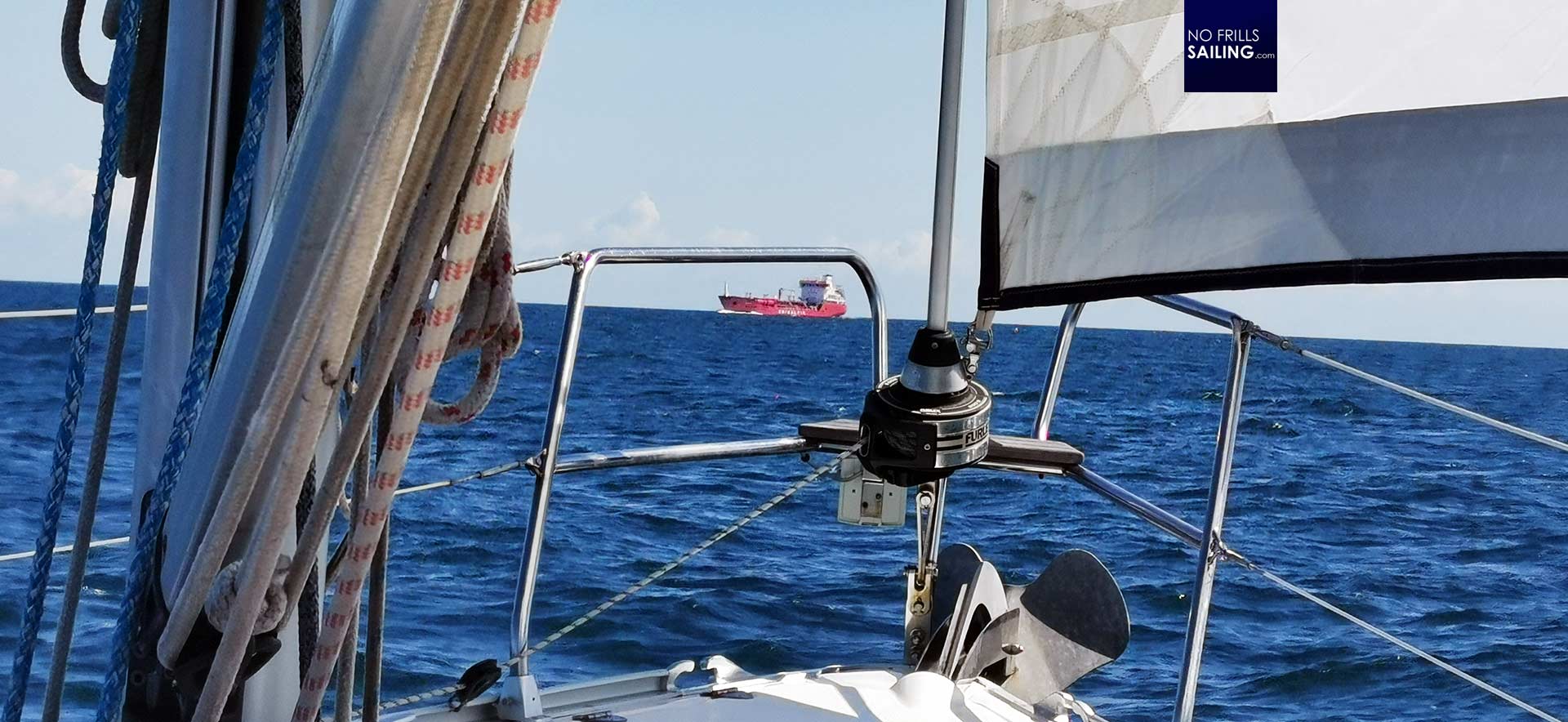
Sometimes a ship would leave the TSS for England approach. Most of the time they had us on the Radar (FREE WILLY is also equipped with active AIS transmitter) and altered courses according to collision avoidance rules. There was an episode with a large cruise ship at night which apparently was killing time, circling our boat in a wide radius 360 degrees by steaming slowly at 7 knots: What an idiotic industry, huge ships wasting precious fuel, circling off the harbours at night just to present a glorious landfall to the passengers just after breakfast …
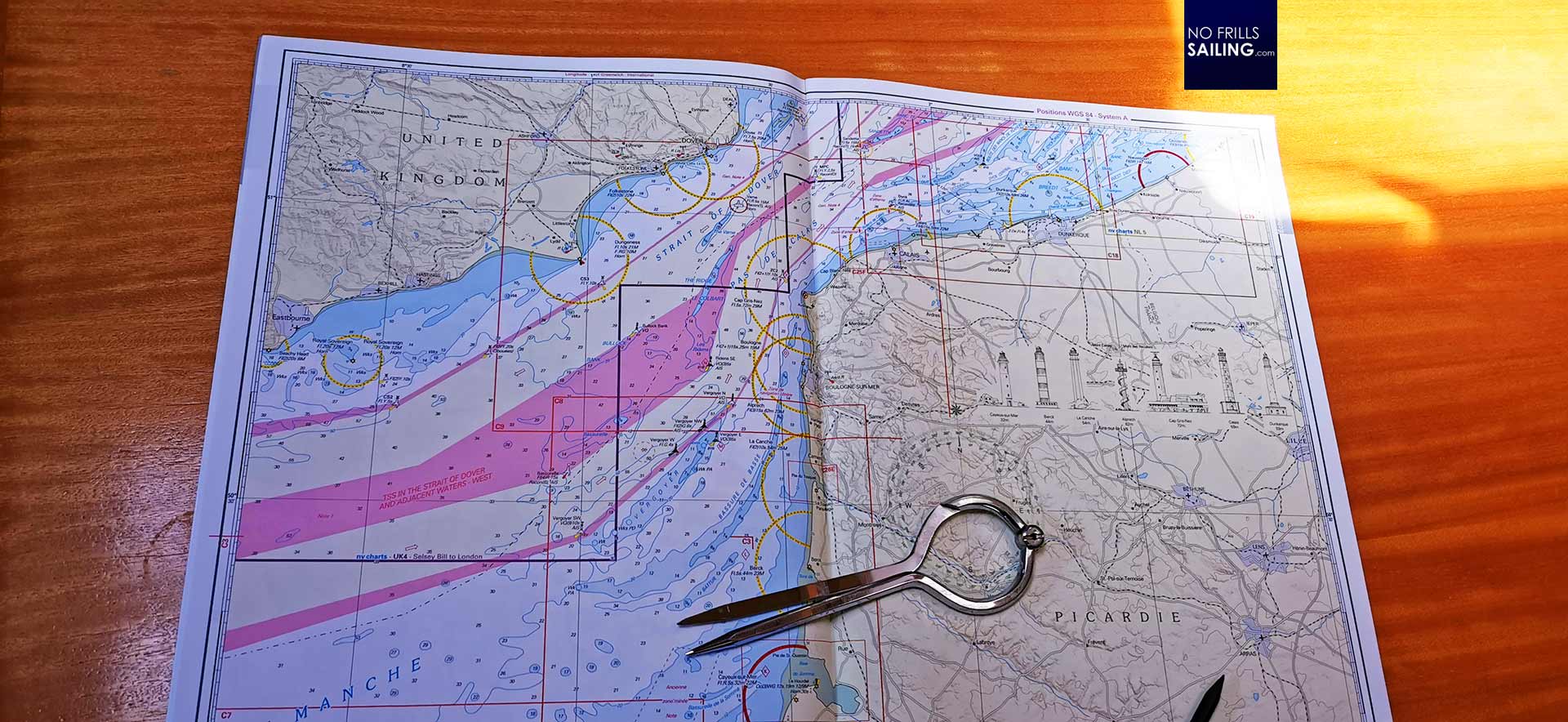
The more we sailed the narrower the Channel became. The naval chart was very much different from the first one now, showing the sleek Dover Strait, being almost completely a huge TSS. We still did not have the impression of sailing on the busiest waterway of the world, Wikipedia states that some 500 ships pass this area on a daily bases, but still, we were vigilant and took it very seriously.

To our regret wind eased almost completely on the third day of the passage. We´ve had already taken in the mainsail, wind barely couldn´t have the Genoa filled bulgy to at least create some pressure in the rigging to stabilize the boat. On the other hand, the calm was times perfectly as we´ve had to start the engine anyway to reload the batteries. Only downside was the hard rolling as waves still came in from astern, making the boat wobbling on any axis. That could not hamper Markus´ efforts to serve a proper, tasty meal and we hailed to the ship´s cook as he finished making a perfect hot stew.
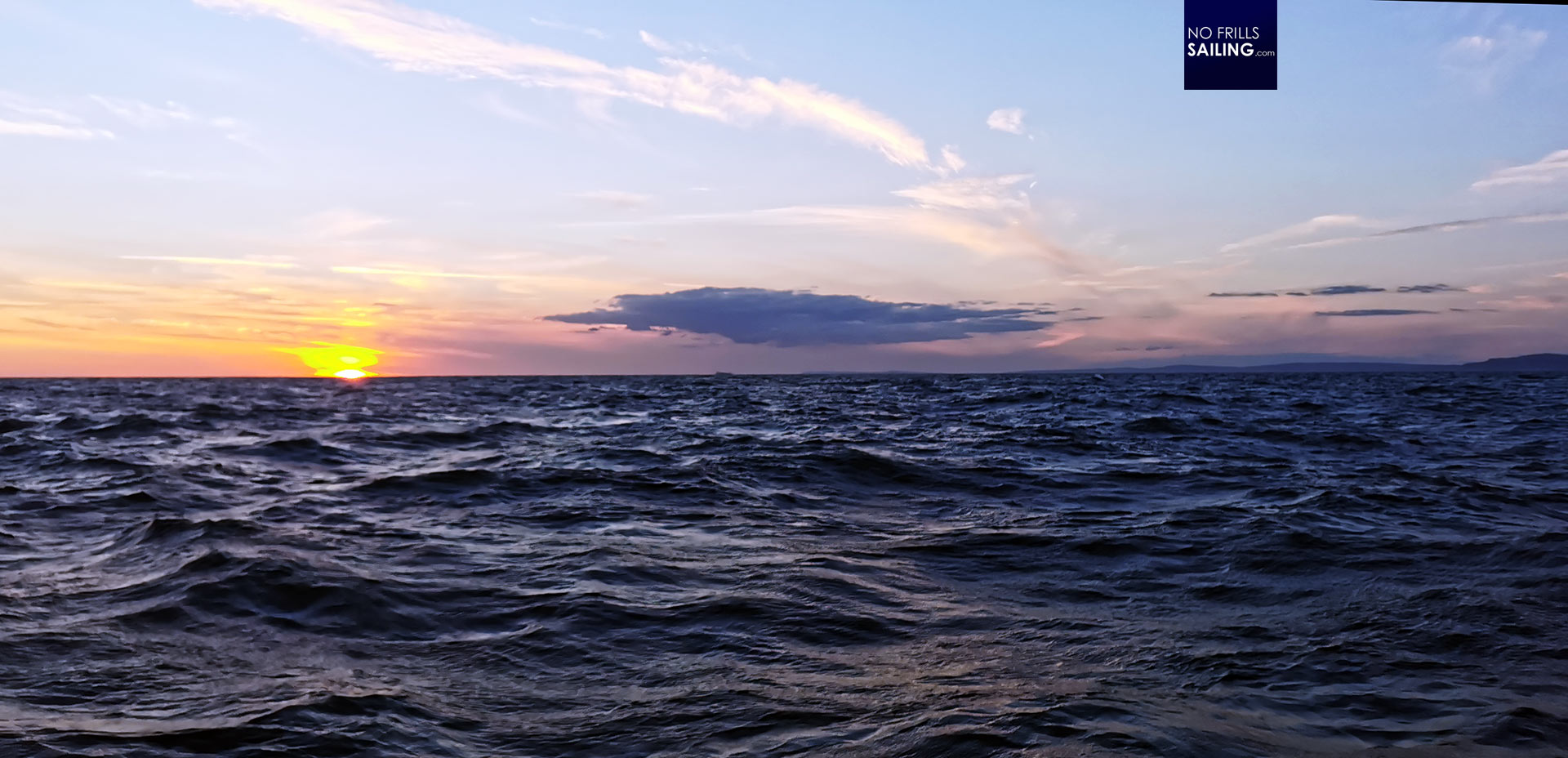
As night again set in we went to the usual process of shifts in which I perfected my system of “small goals” (about which you can read in this article, paragraph “Exhaustion builds up”). Unfortunately we had to run the engine all night, even increase rpm to at least do some mileage during falling tides but we also made steady progress towards the Strait of Dover which was due for passing by the coming day. According to my own calculations we would be happy this time to see it in broad daylight – as all the other highlights along the way had been passed during the night.
Bye, bye, ol´ England: Into the North Sea
And finally we were there. Somehow the boat´s routine, the ever coming and going tidal currents, sun and (full!) moon alternating, brushing teeth, eating and drinking, our daily routine, was interrupted by Markus yelling down: “Dover Strait!” and we all dashed up into the cockpit: “Now we really are in the Channel!”, I stated as slowly but surely that classic scenery was beginning to build up before our eyes. Finally, finally we would get our cliffs, the steep white breathtaking chalk-rocks which are synonymous with “English Channel”.
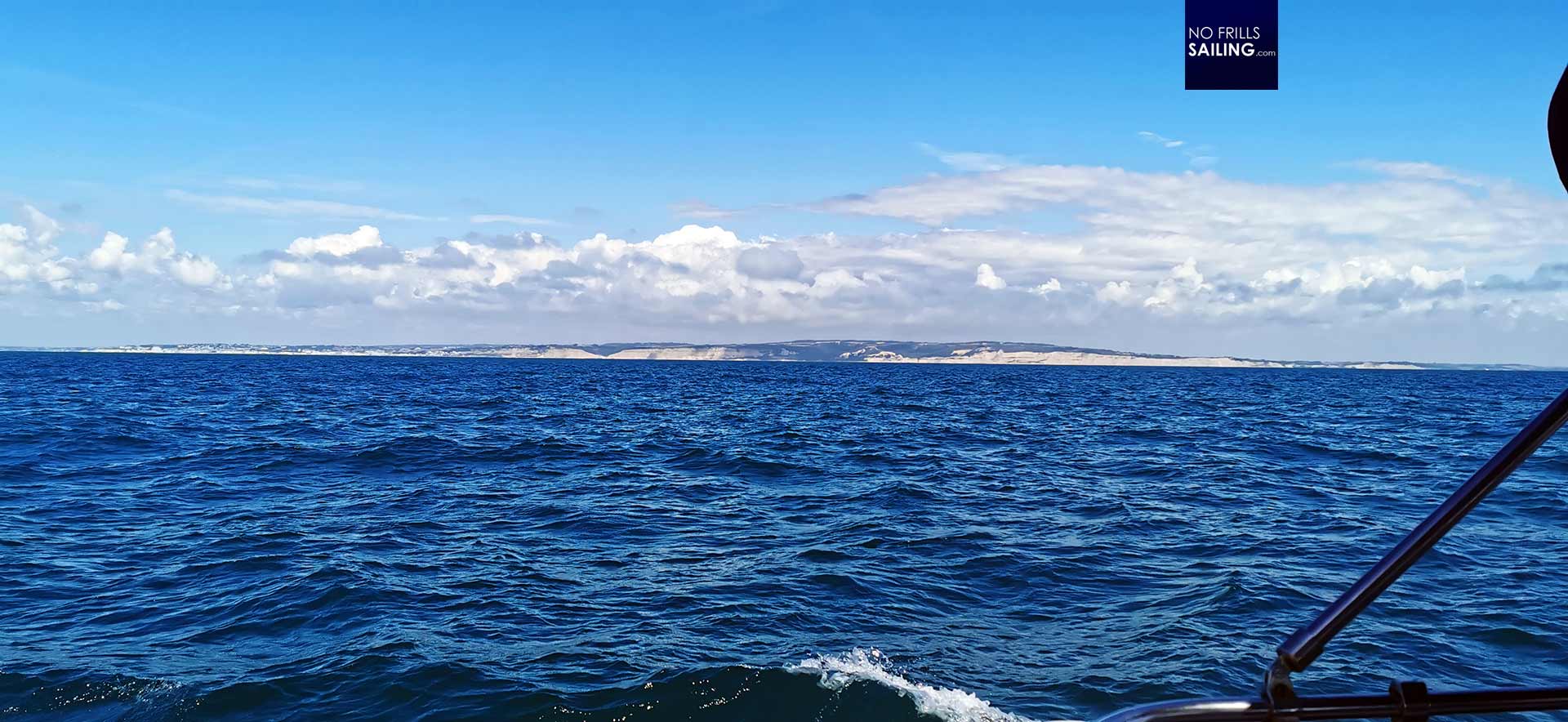
As wind was starting to pick up speed again we unfurled the Genoa again and were able to slow down the engine as well. It had become slightly colder now and I could judge by the change of the clouds in the sky that weather was about to change. Getting a fresh forecast wasn´t possible as surprisingly enough we did not had mobile phone connection and thus no internet connectivity – although being no less than 5 miles away from the English coast – what a difference to Spain where we would have LTE-quality fast mobile internet up to 20 miles distance to the shore!
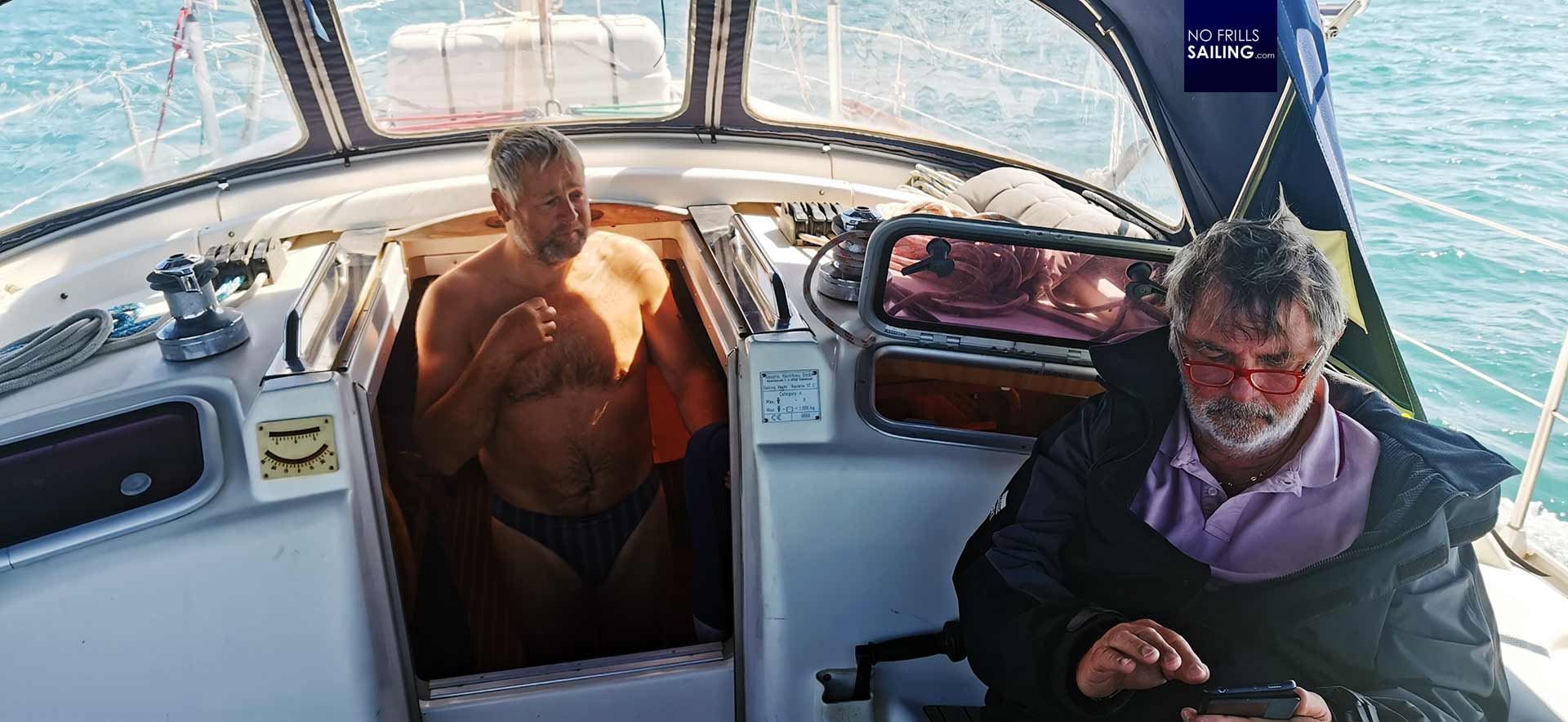
I was excited as my watch was the watch when we would pass Dover Strait. Markus shortly got up and shot some pics, the Skipper was still desperately trying to catch a connection. I sat behind the helm and enjoyed the marvelous view: And still, being at home now the third week after that trip, I very much regret that we didn´t had a chance to really go there and soak some of the English atmosphere in one or two of the harbours there. I definitely need to return!
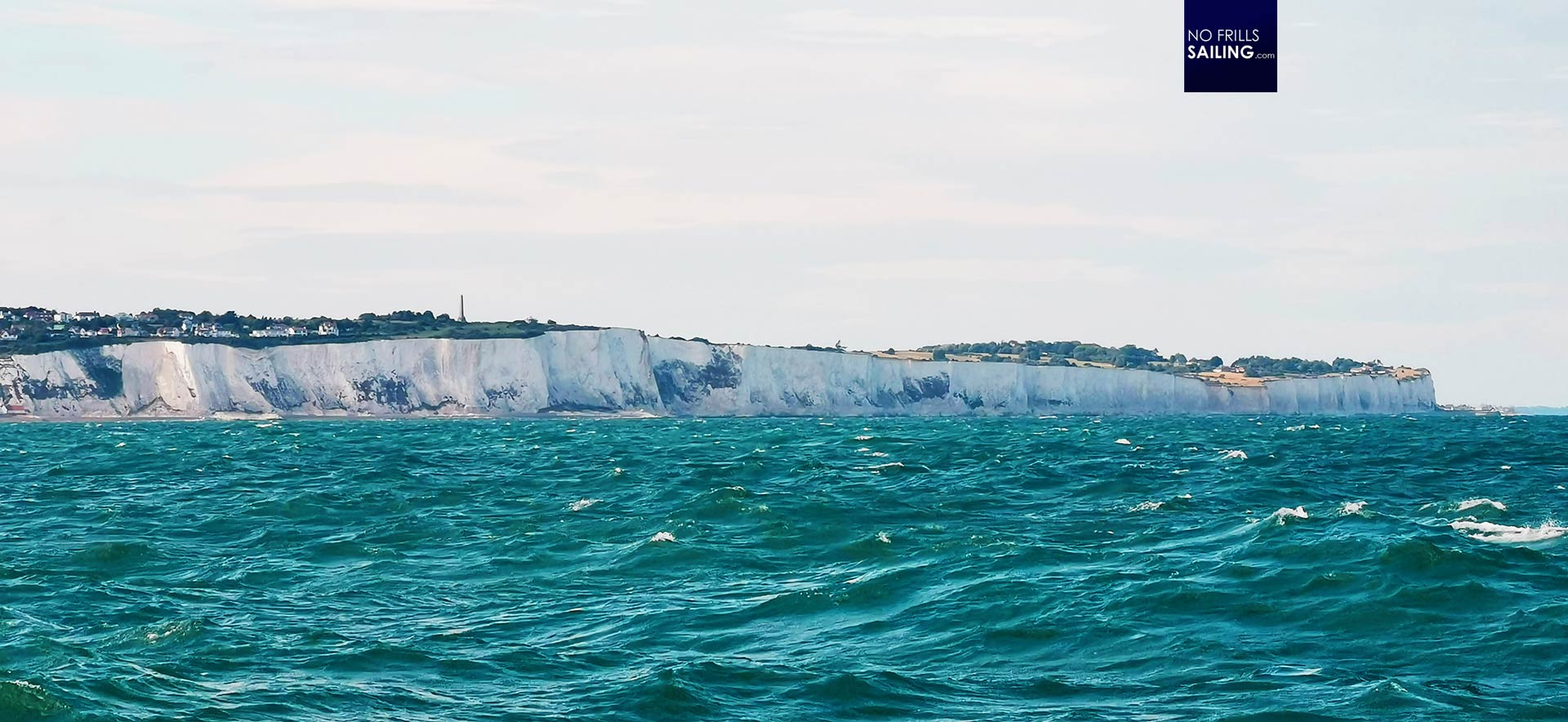
Passing Dover cliffs finally was a glorious moment though – in awe we watched the mighty white chalk-rocks passing by. What a pretty contrast to the greenish water. A P&O Ferry dashed pass us at our stern, reminding me of my last real long visit to England during a school exchange in 11th grade – what a waste, I thought, not to having returned here ever since. We as well could see the French coast line on the opposite side, realizing how narrow this strait was in reality, compared to the vastness of the western end of the Channel.
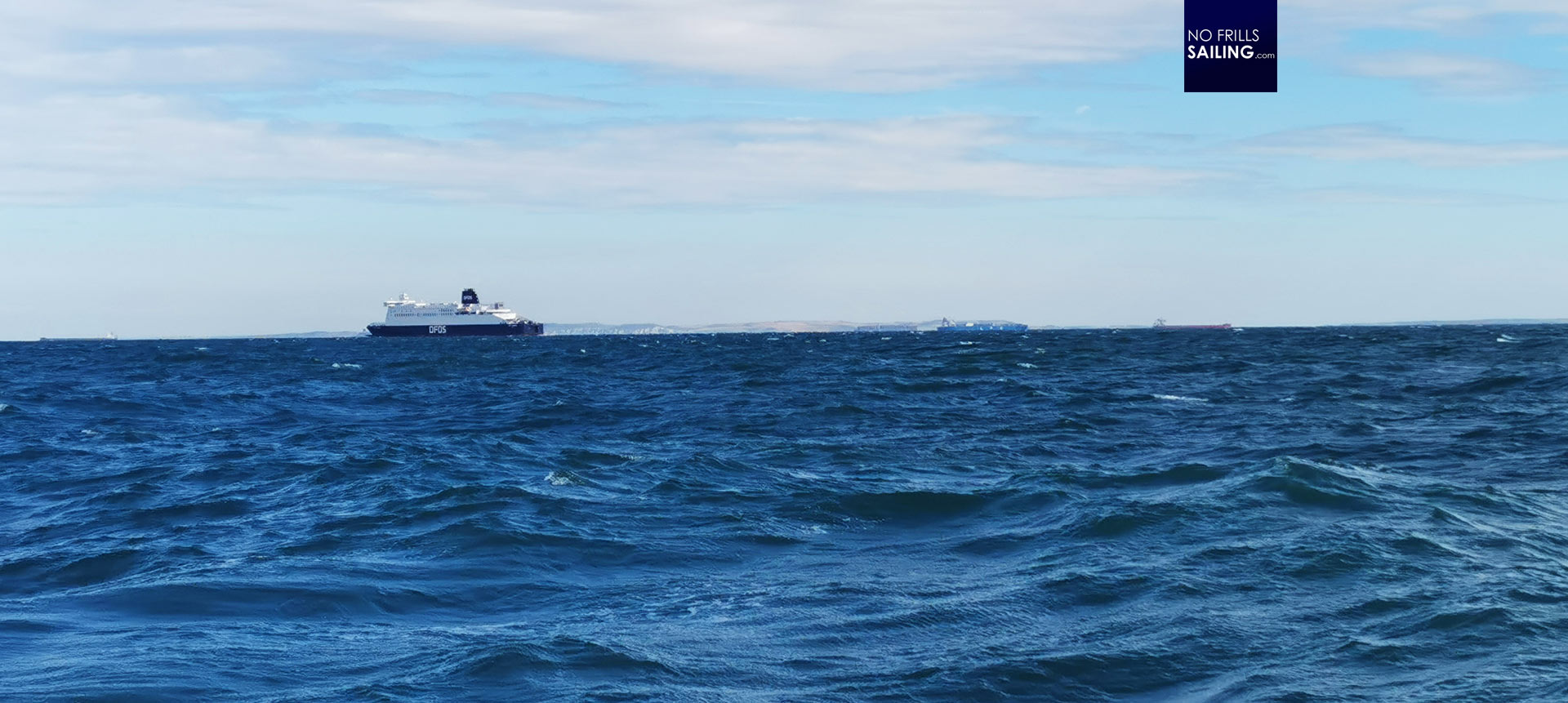
I altered course to some 040 degrees, still avoiding the TSS. As we now began to crawl up our way along Belgian and Dutch coastline, I under all circumstances wanted to avoid Rotterdam approach – which is a pretty complicated mix-up of traffic separation schemes, fairways, roadsteads and wind parks. The idea was to sail past this mumble in the North and then turn into Amsterdam/Ijmuiden on a straight 090 course due East.
Weather is gearing up
Now, a last trial was put upon us by Rasmus, the mighty God of the Winds. As we slowly cleared Dover Strait and entered the North Sea, rounding the Canterbury landmass, weather changed dramatically. First of all wind began to set in again and with power: As it was blowing directly from astern taking out the mainsail wasn´t a thing and flying with 6 to 7 knots almost perfect. With the wind, waves started to build up again.
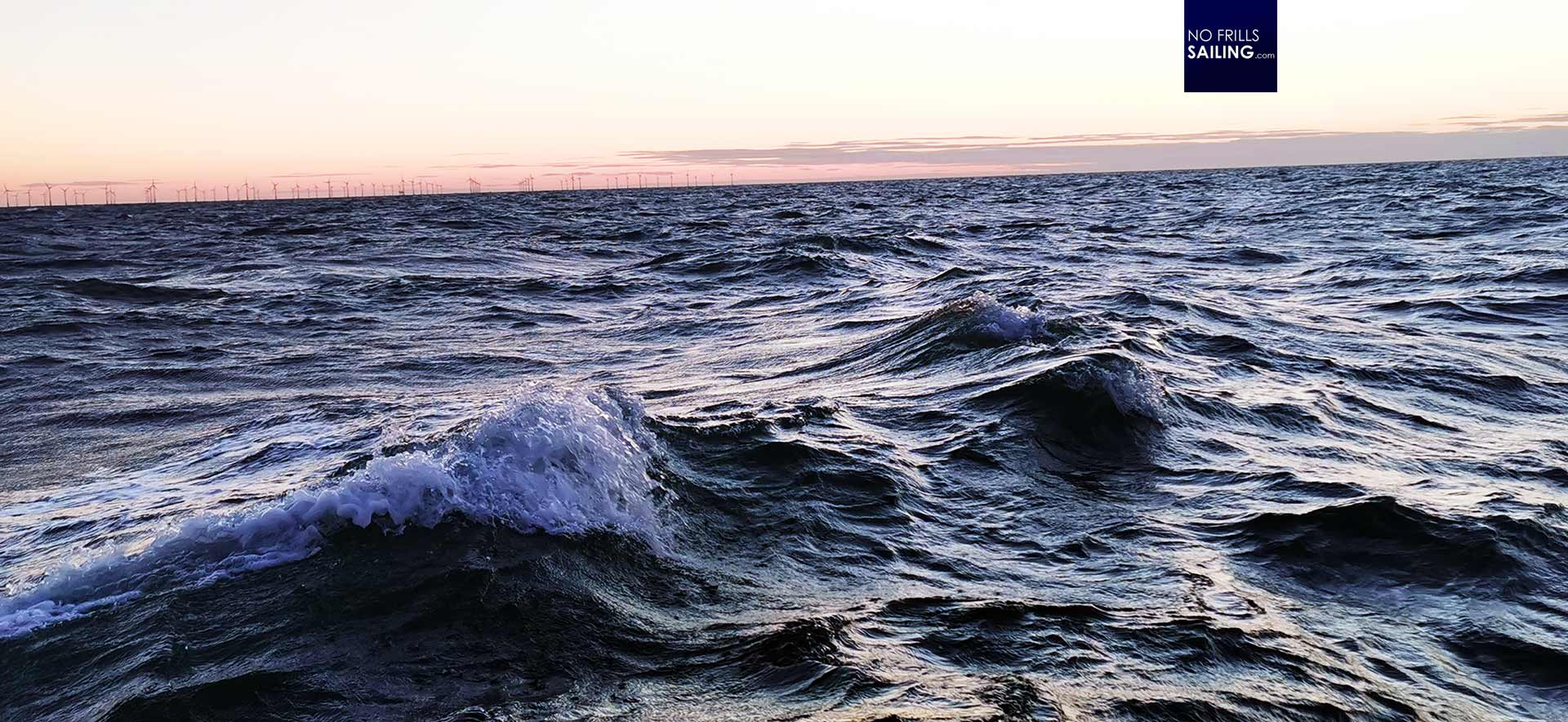
Which was okay if not another wave-system began to mix itself with the old, already known waves from abaft. These new waves rolled up against our port side stern from the North, possibly a remnant of a stronger wind blowing up there. In a matter of one or two hours the boat began to roll absolutely violent and it became impossible to walk around without being forced to grab a handle and hold very tight to it. We luffed a bit, meaning altering course to the North, in order to stabilize the boat, but the violent motion remained.
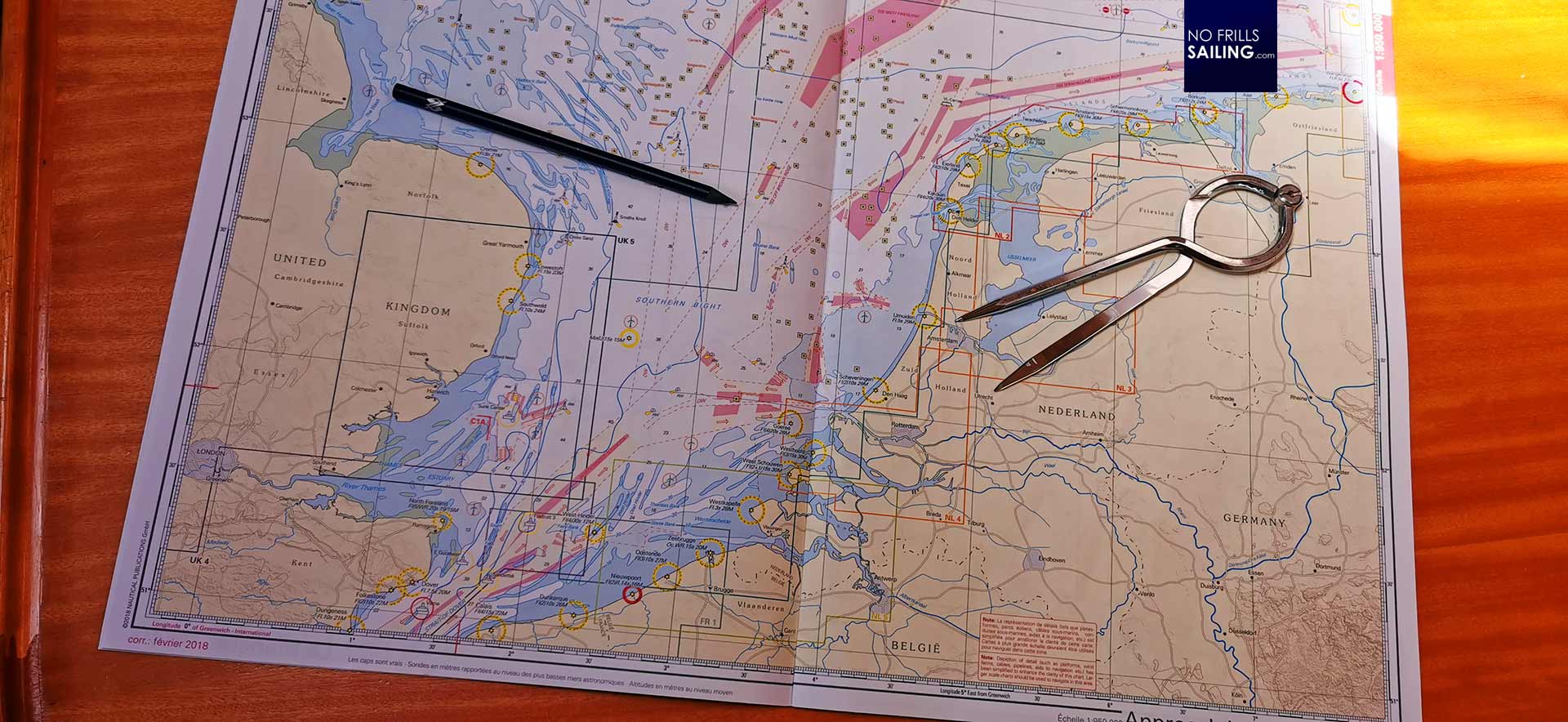
Leaving two large offshore wind parks to our port side and looking astern I saw a bright wide glow over the skies just in the direction where London was. I don´t know if the brightness of this city is sufficient enough to create such a huge effect dozens of miles away, but it was awesome to observe. In that night rolling became so gross that absolutely nobody of the crew off duty was able to sleep. The crossing seas – building up to 3 metres every now and then – were shaking the boat ever so violent.
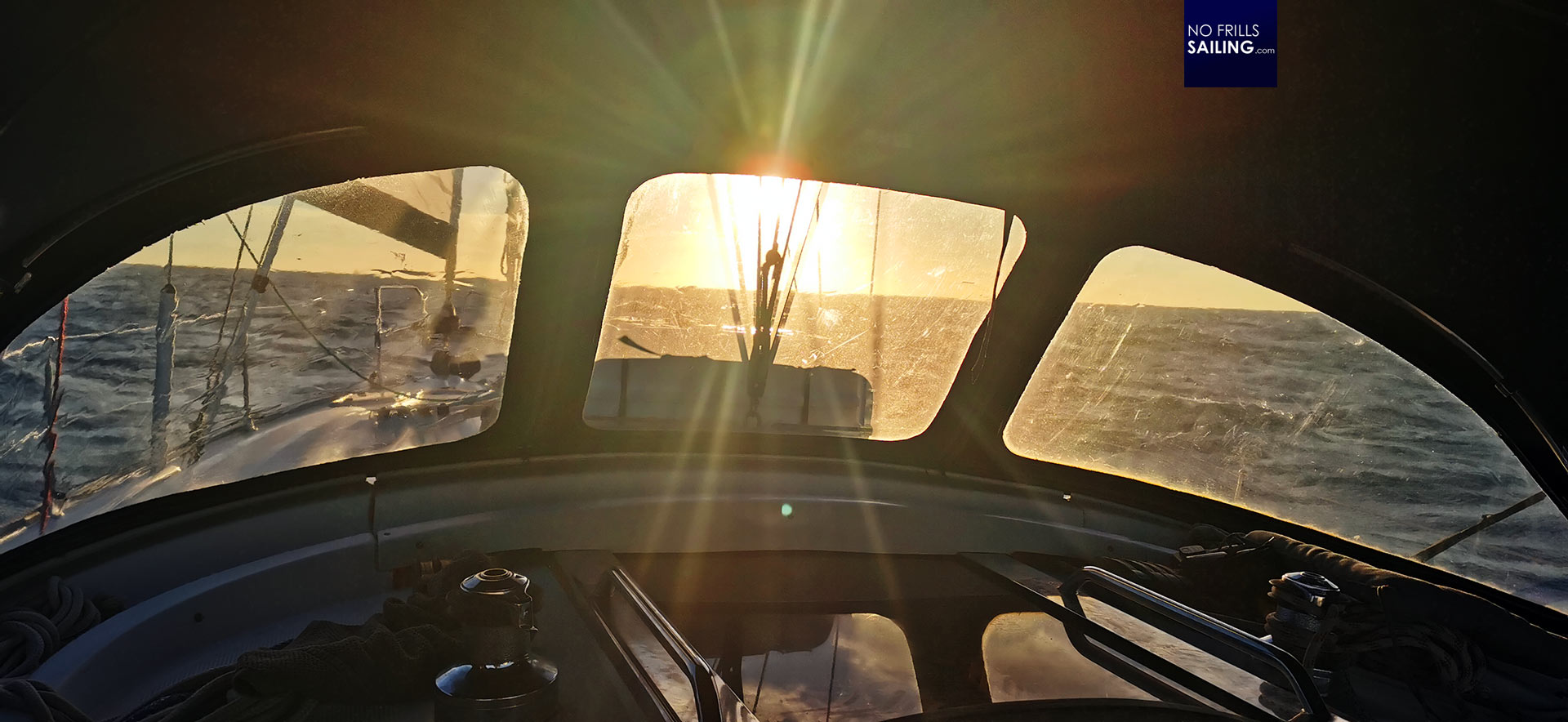
As fast as it came, it disappeared. Wind died down during the morning hours well within my shift so that I had to take in the sail and start the engine again. Unfortunately the wave system still had pretty huge inertia and energy so that the motion of the boat remained unbearable for hours to come. With the sun coming up a new day was born – the last day of our journey, as I calculated.
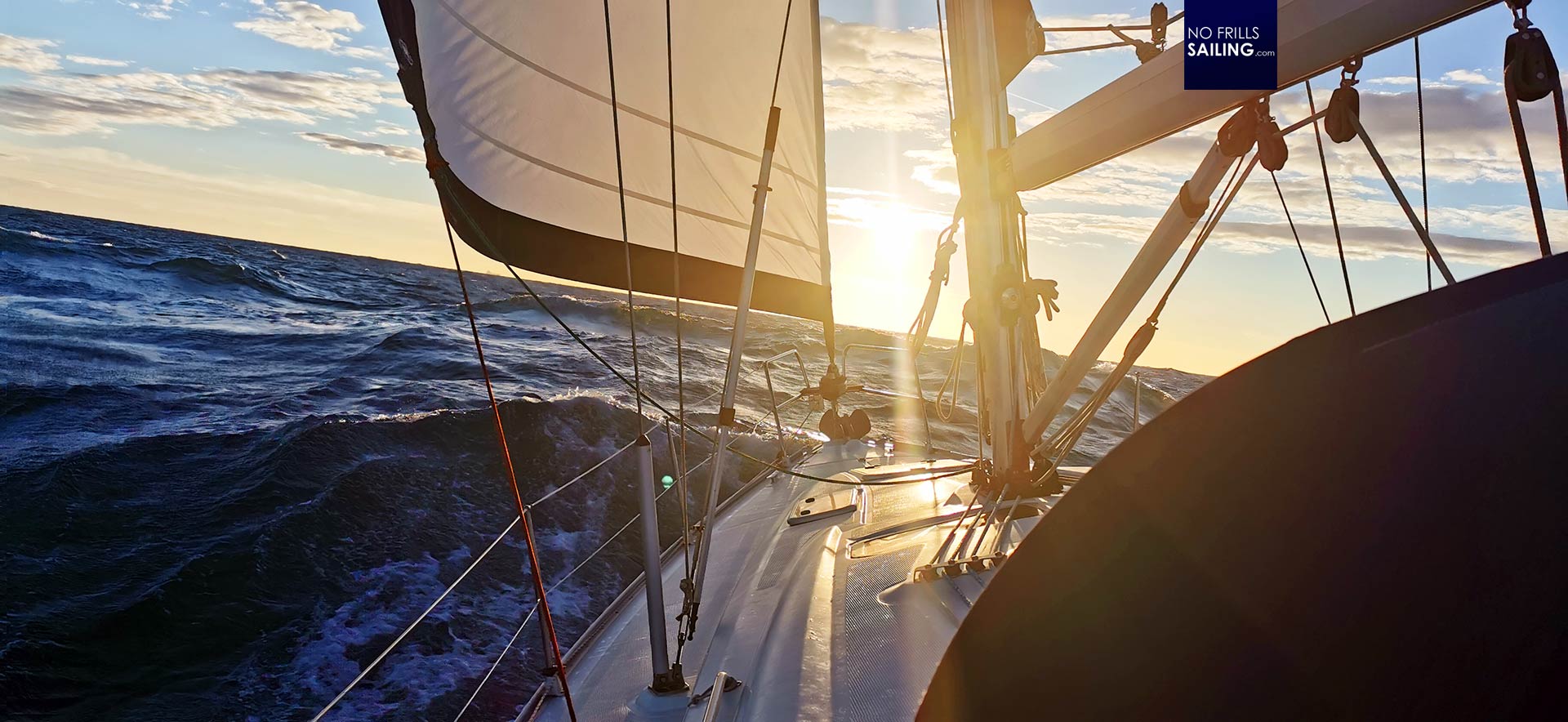
Later around midday the Skipper took out the Genoa again as some wind has returned, but engine kept running. We had sailed past Rotterdam to our right hand side and it was time to swing around to East in order to bring FREE WILLY to her final destination (at least of that leg) – the Dutch Sea Port or Ijmuiden. During the past four days we regularly talked about which harbour to go for: Wilfried, the skipper and owner of the boat, had to consider many facts like arrival and reachability of a port for the next crew, possible weather windows to either sail her out through the open North Sea of “inside” through the Ijsselmeer. We fancied Ijmuiden as it apparently lived it to many of the premises set.
Goede dag, Ijmuiden!
Same as approaching Brest, it was a long, long, long and seemingly never ending succession of boring hours nearing the Dutch coast. We clearly could see the harbour from far away – a distinct black smoke cloud was hovering over Ijmuiden as a perfect yet disgusting marker. Ijmuiden is a small town some 30 kilometres away from the Dutch capital of Amsterdam and the port of entrance to the huge channel-system of the Netherlands. Mid-sized freighters, tankers and other commercial ships do approach Ijmuiden as well as large cruise liners.
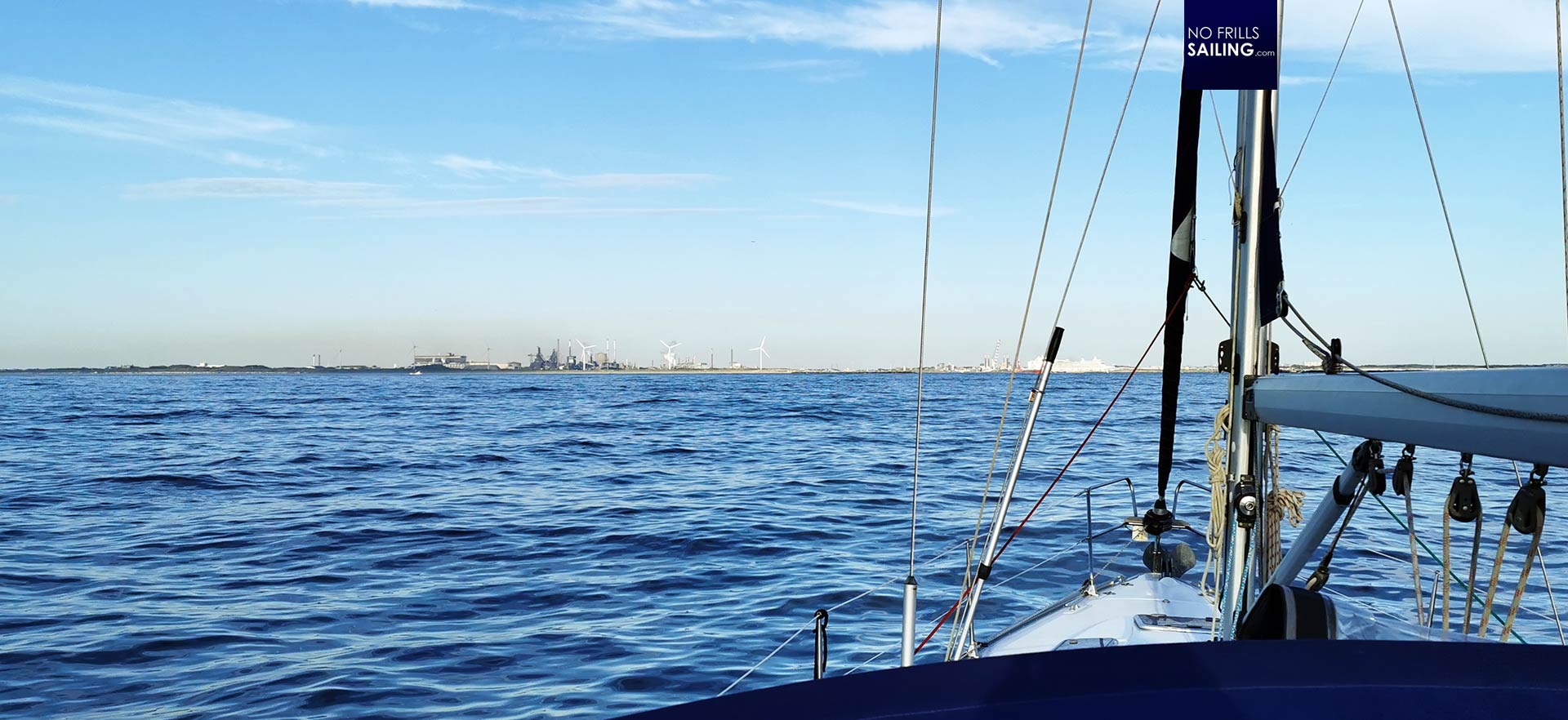
We kept to the fairway and steamed along the green buoys. Passing a fleet of a dozen tankers on anchorage, waiting for their precious crude oil freight to be pumped in – or just a fleet of hulks put out of service due to the worldwide recession? What I noticed though was that the now from starboard side pushing high tide created a current that was powerful enough to make us sail a huge detour due to drift. I had to apply a correction angle of up to 20 degrees in order to achieve a straight course to the breakwater. Fascinating! I found it also fascinating to imagine sailing the opposite direction, say, if you´d bring your boat down South: Sailing this Channel upwind against these waves, rocking winds and tides? “Impossible!”, the Skipper agreed: “In that case you´d have to wait for an Easterly to blow you through.” Well. I don´t really sailing like the North Sea and I again have been confirmed by the behaviour of these waters again.
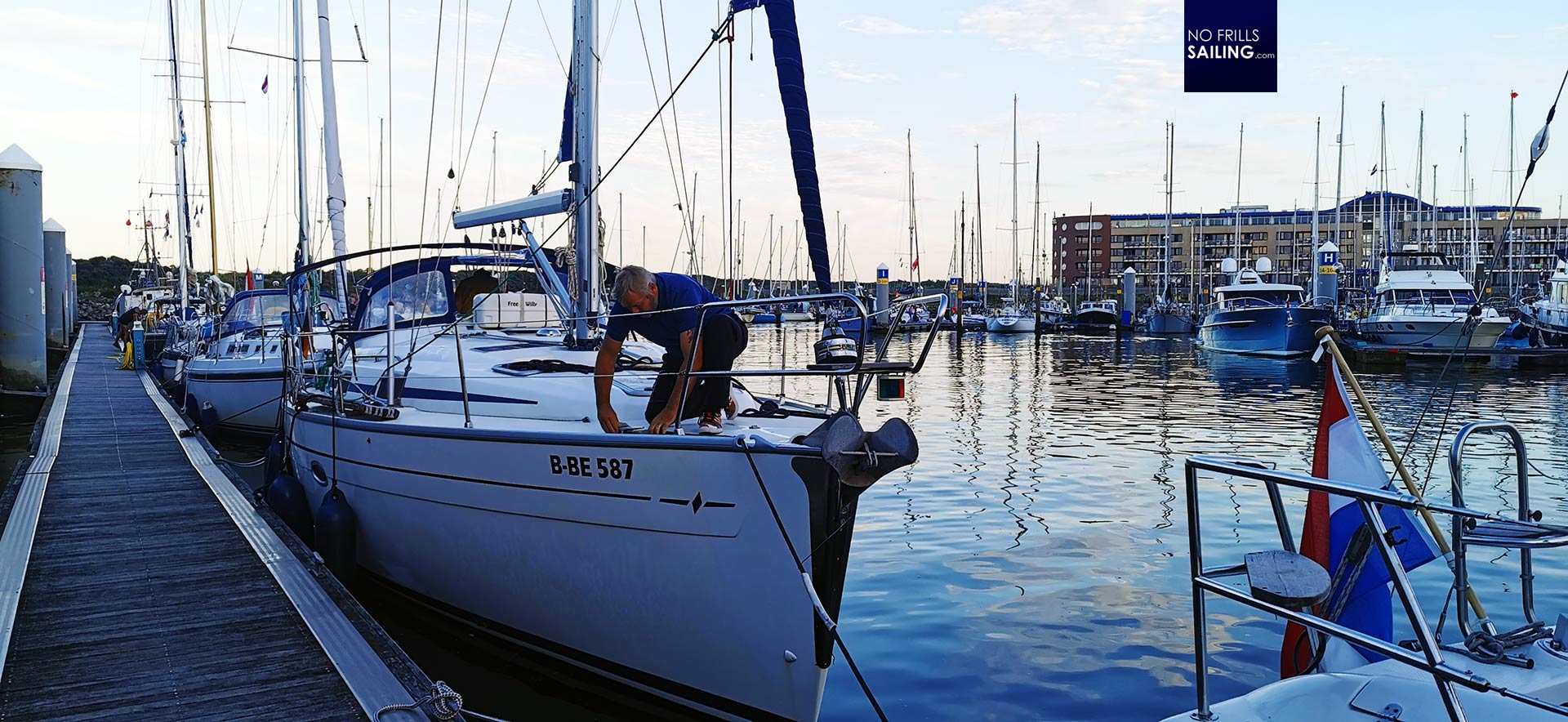
In any case, my calculations of a landfall that day have been spot on: We sailed past the approach buoy and entered Ijmuiden Sea Port at 6 p.m. and moored the boat happily at the receiving pontoon. As sun went down, a last ice-cold Portuguese beer we bought back in Porto two weeks ago has been hauled on deck and we saluted to each other, to the brave Bavaria 37 and to Rasmus, congratulating us for the successful conclusion of this trip.
Mighty, mighty tides!
I began to check the log and the internet. Now blessed with a fast connection I re-entered our actual track into the program and looked at the numbers: Starting in Brest, sailing around Brittany, crossing the Channel to the Isle of Wight, passing Brighton and Dover, sailing a bit North just to curve into Ijmuiden would amount to a total distance over ground of some 470 nautical miles.
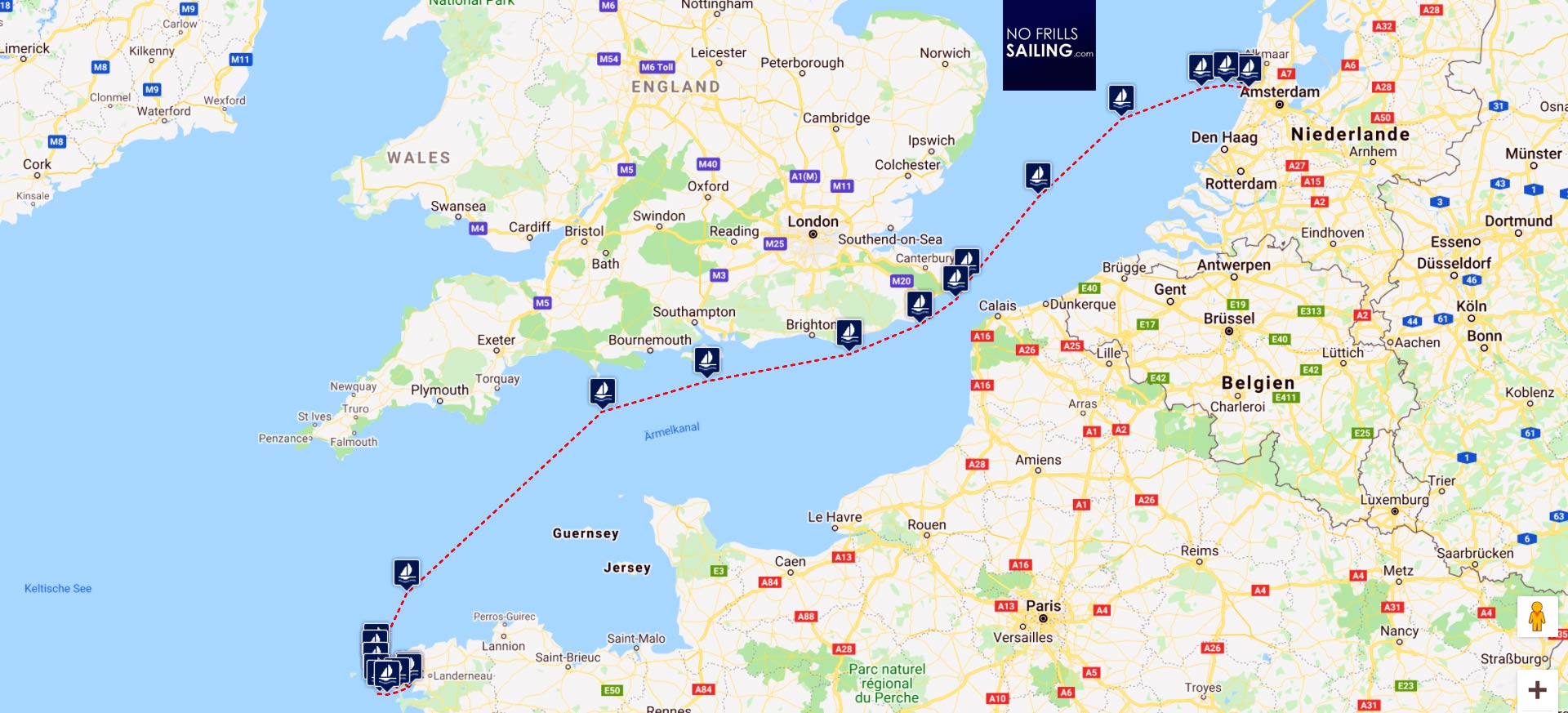
Now I checked the logged distance sailed according to our onboard-instruments. Sailed distance is determined by the way made good through the water. I couldn´t believe my eyes: The screen clearly stated 570 miles! That is 100 miles more than over ground. The only explanation (putting measurement glitches and of course small detours and course diversions) is that the force of the tides and the head-current was adding 25 miles per day over the course of these four days. Absolutely amazing!
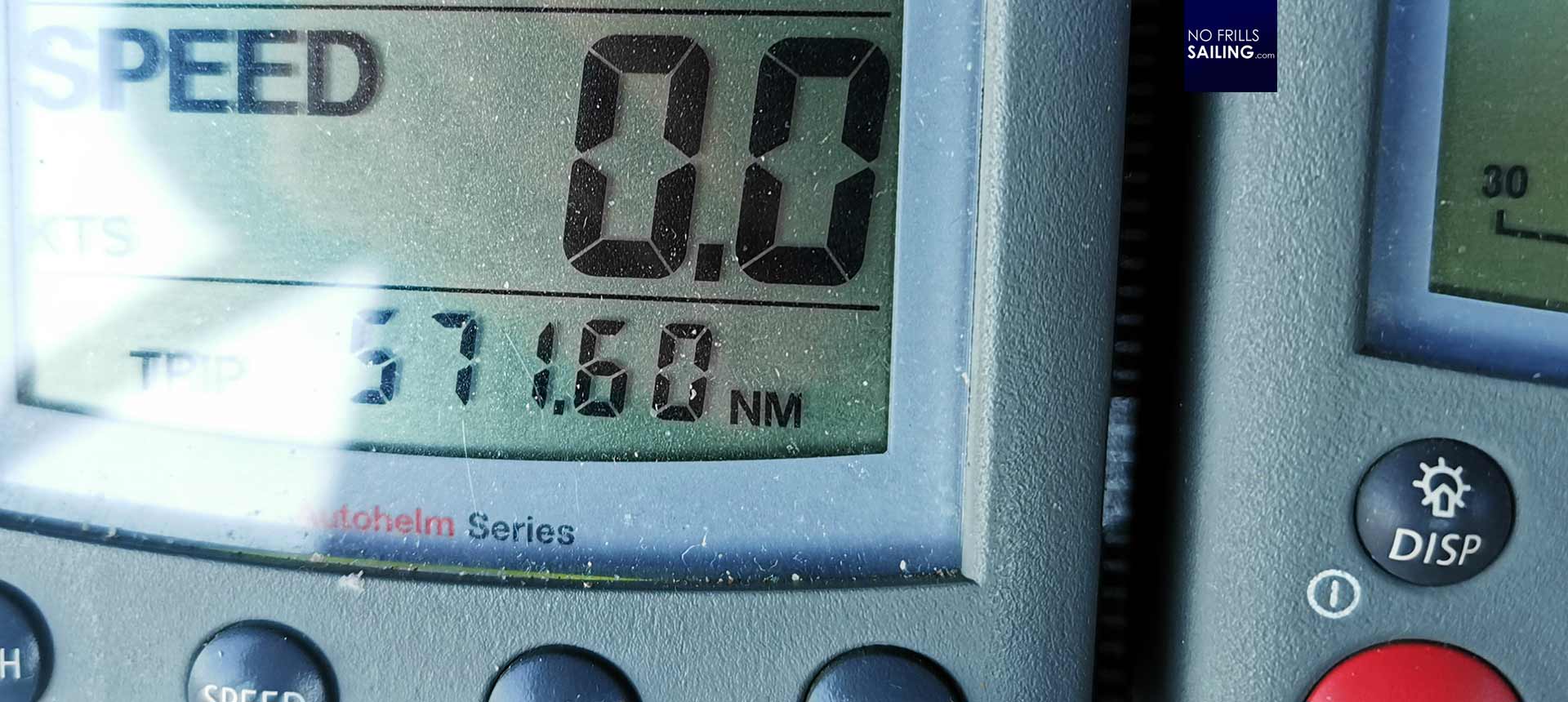
This is also why I love sailing: The firsthand experience of the magic of nature. The force of the elements, this aeon-old game of the moon playing with our Earth´s waters. Of course I had previous experience with the tides but never such an awe-inspiring long lasting study. This was the most impressive aspect of this trip: Experiencing the sheer power of that force. My respect for the old seafarers who tackled these forces without any modern instrument´s help grew even higher.
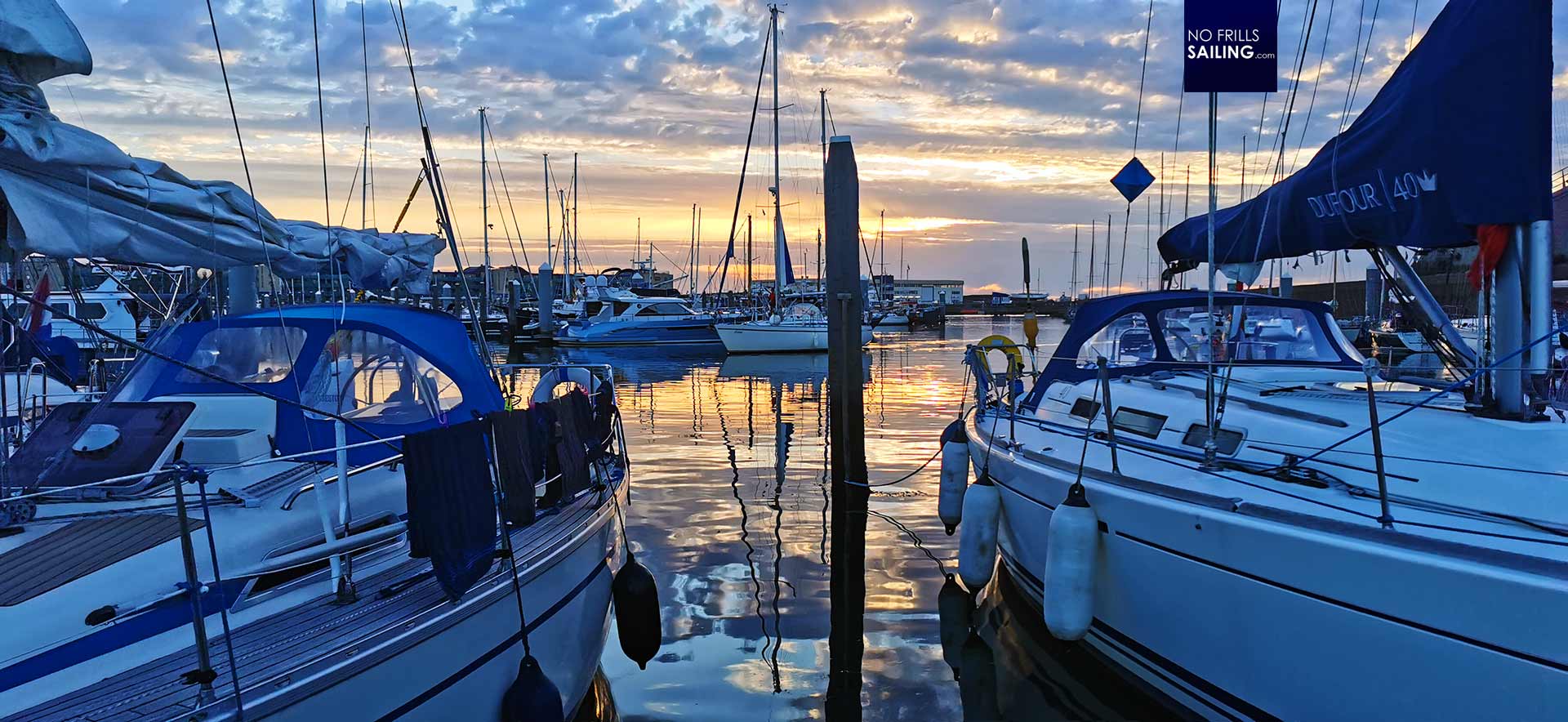
As the sun went down we sat in the cockpit, emptied another can and slowly let that fourth and last day of our English Channel trip fade. A tremendously impressive cloud-scattered sky was the perfect setting for a red glowing sun to set in the West, creating a strange feeling, a mixture of deep satisfaction, pride and excitement on the one hand and a sad feeling of something so exciting finally drawing to an end. I slept wonderfully calm that night.
Time to say Goodbye, Skippy
On the next day we brought the yacht to her new berth closer to the marina´s entrance and spend a day off – the first true vacation day with sun and everything since two weeks. A full-fledged breakfast at one of the beach bars (no Covid-19-precautions, no masks, not whatsoever – strange …) and enjoying the warmth of the sun. Packing my stuff, cleaning up the cabin that has been my home for these two weeks was a bit sad, nevertheless, I knew that a new crew member would arrive in the coming days to replace my position aboard and help the Skipper to bring home FREE WILLY to the Baltic Sea again.
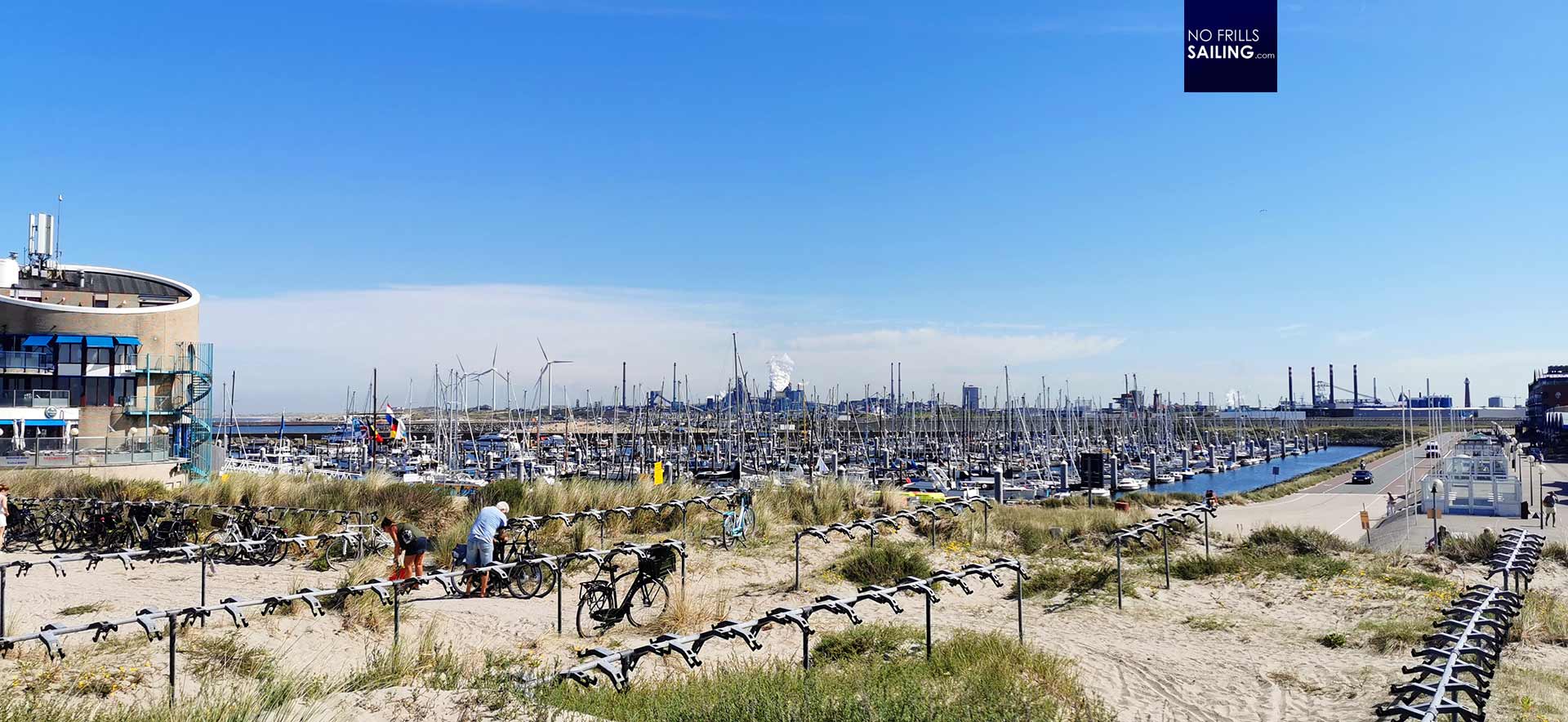
In total we have been underway for 12 days, totaling some 190 hours at sea. That said, the log stopped at exactly 1.202 miles which I proudly wrote onto the list for confirmation of my nautical miles. I learned so many things during this trip – some of them are already written down in these articles, some may need some more time to think about. I thank Markus for being a perfect crew mate and such an aspirational cook, I thank Wilfried “Skippy” for considering hiring me for this awesome “job” of being part of the “FREE WILLY Homecoming”-crew. We left early next day by train, back in my car five hours later driving home to Luebeck I couldn´t stop thinking about this awesome sailing experience. For sure, I will come back to meet the fascinating waters of the English Channel as well of the mighty Bay of Biscay.
You may read all articles of the Biscay- and Channel-crossing by clicking on this hashtag #biscaysailing
Also interesting to read:
Preparing for a long sailing trip
Celestial Navigation, Parts 1 and 2
What is the Froude number?
